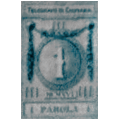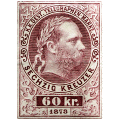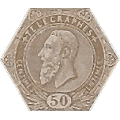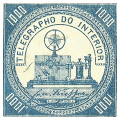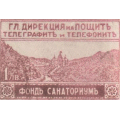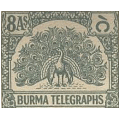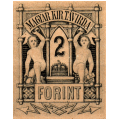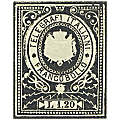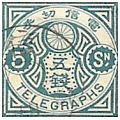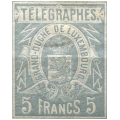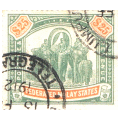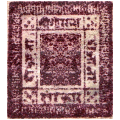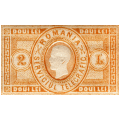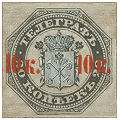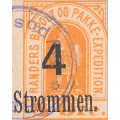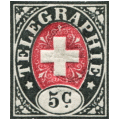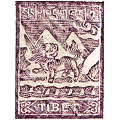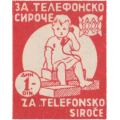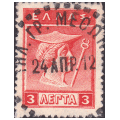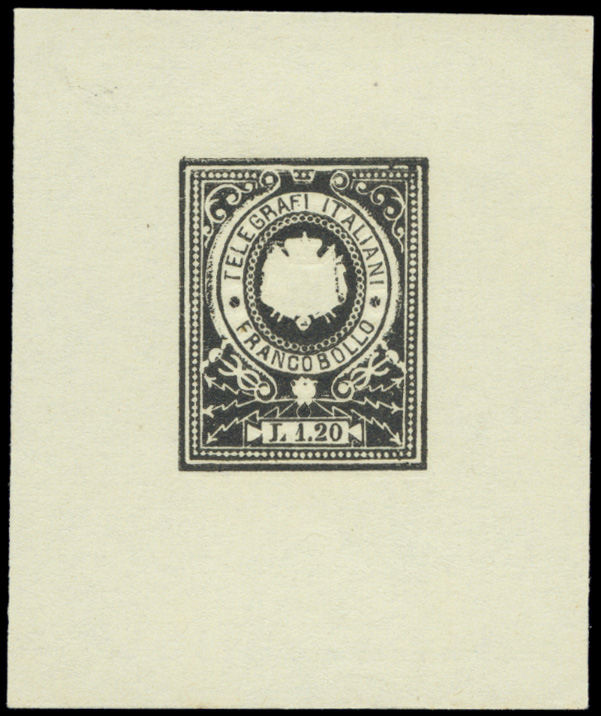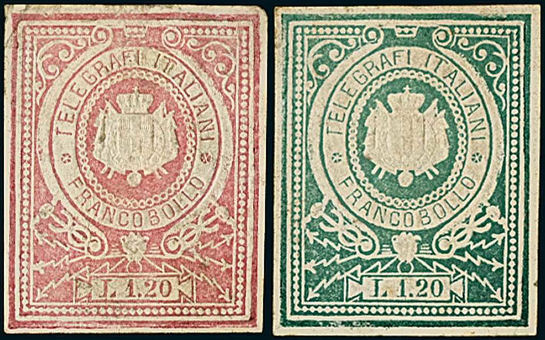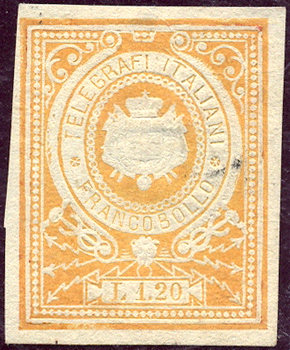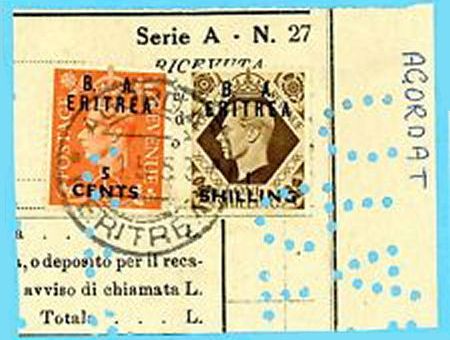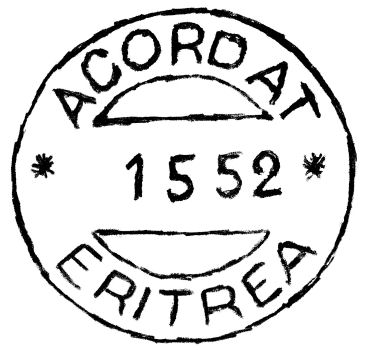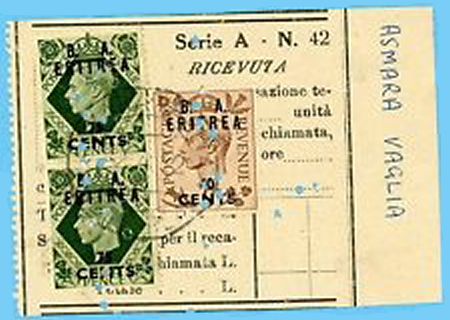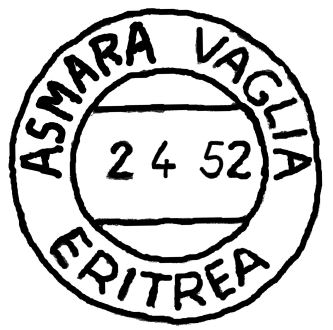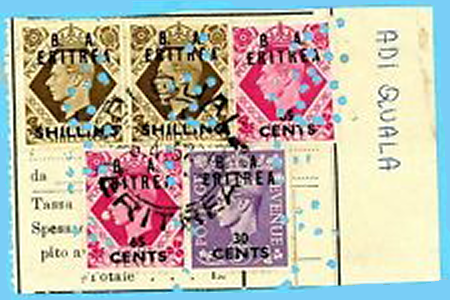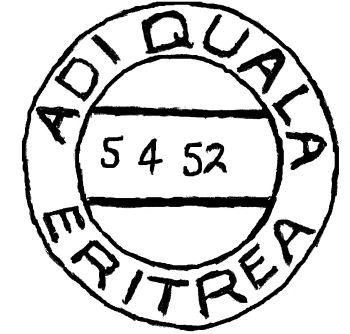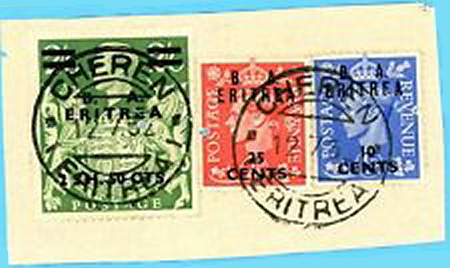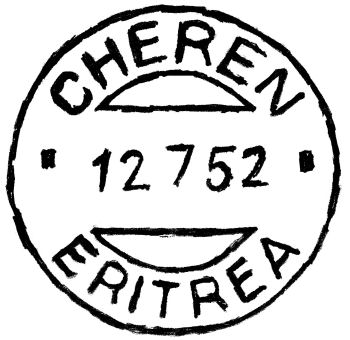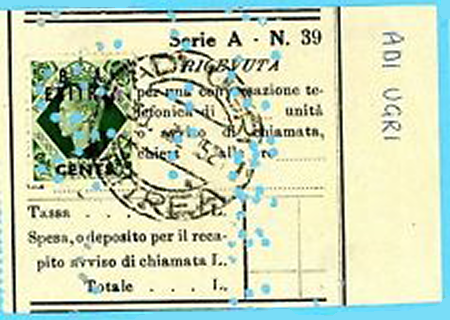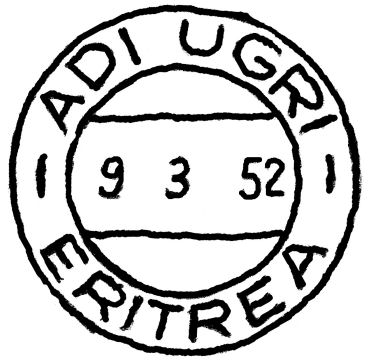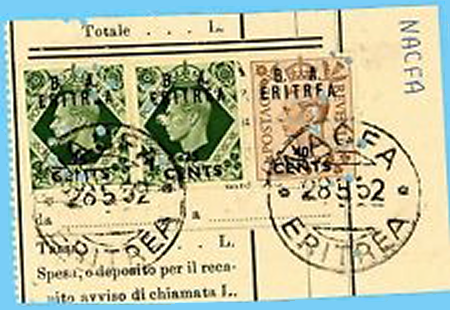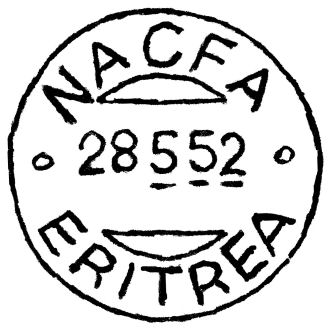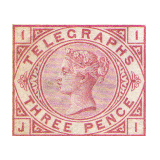 |
Telegraph stamps of the World
I started with just British Private Telegraph stamps, but I have decided to
attempt to update more of Hiscocks' book.
Click here for a site-map.
|
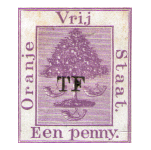 |
| Übersetzen sie |
WORKING
|
Traduisez |
| Traduca |
Traduzca |

I have re-numbered these in the light of new information,
though leaving references to the original designations.
The new designations have 'RH' numbers (Revised Hiscocks) to avoid confusion.
CheckList Setup |
ITALY.
Steve Hiscocks wrote:
So far as I have been able to discover no telegraph stamps were ever issued or used in Italy. The issue of telegraph stamps was however apparently
considered at one time since two designs of essay are known — one value of each in a variety of colours. Little is known about them. They are listed
below as an aid to collectors who may come across them from time to time. The illustrations are taken from a 19th Century publication and are unfortunately very poor.
My note:
I have added a few more essays, plus some apparently for Sardinia.
Only essays and proofs are known. 1862? Imperf.
I have tried to arrange these into what I think is the likely sequence. (I could be wrong)
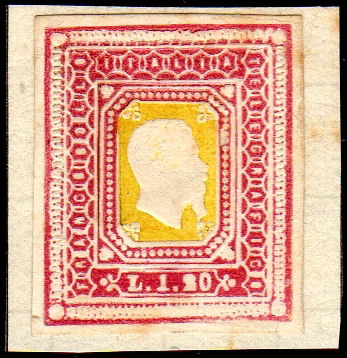 |
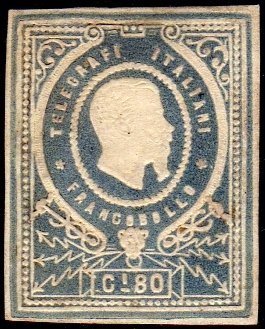 |
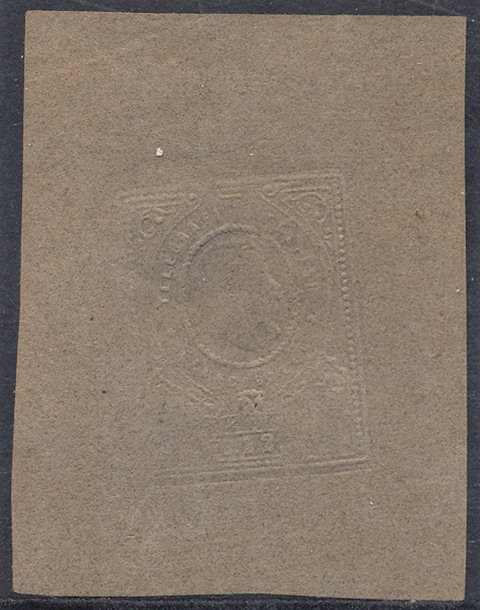 |
Type 1. (H1) Embossed bi-colour Ll.20 Telegraph essay ?
head of King Victor Emanuel II. |
Type 2. (H3) New design.
80cts. Head of King Victor Emanuel II. Proof ? |
Type 2. (proof) Looks like L.12 Telegraph proof embossed on on tan card.
Image courtesy of Rolf Lampbrecht. |
Types 1 and 2, courtesy of Andrew Higson appears to be previously un-described.
I am not sure of the dates for any of these except that Victor Emanuel (known as the Duke of Savoy) became king of Sardinia in 1849,
then on 17 March 1861 he assumed the title King of Italy. He died 9 January 1878.
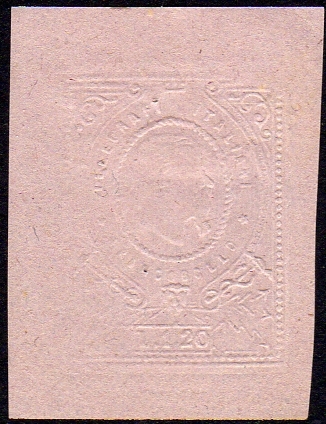 |
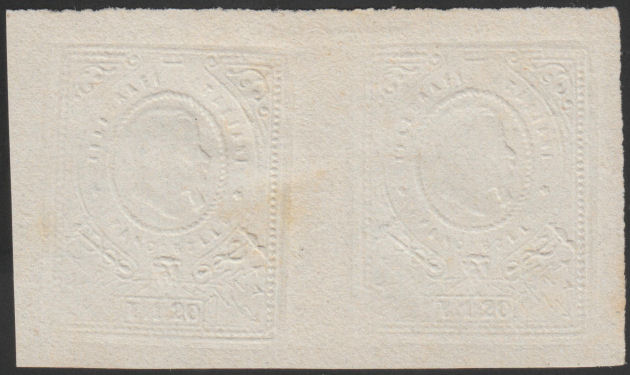 |
Type 2. (H2) On pink paper.
Proof of embossing ? |
Type 2. (H2a) A pair of the embossed heads on white paper, |
A similar design, with Coat of Arms instead of Head.
These two items were advertised as essays of Telegram Seals of this same period.
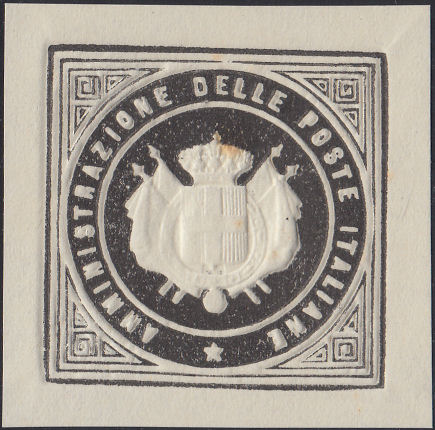
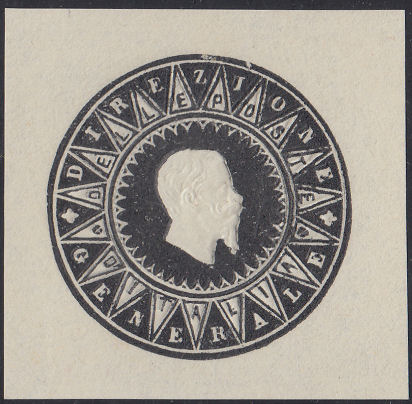
Though they are of the same style, they contain no reference to 'Telegrafni', so I would think they were intended as general seals.
The square one though does have some resemblance to a later type used as a Telegram seal (see below).
1864? Hummel essays Imperf.
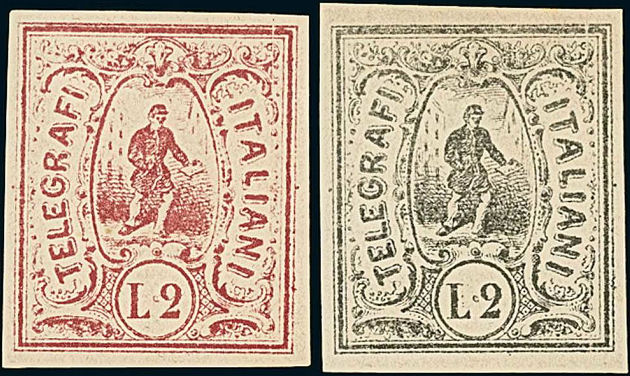 |
Type 4. Courtesy of Fabrizio Ferrari.
The range of colours described, suggest colour trials. |
| RH # |
Type |
Was |
Description |
Mint |
Used |
| H5 |
4 |
2 |
2 Lire. grey-black. |
- |
- |
| H5a |
|
2 |
purple |
- |
- |
| H5b |
|
2 |
lilac |
- |
- |
| H5c |
|
2 |
blue |
- |
- |
| H5d |
|
2 |
greenish-blue |
- |
- |
| H5e |
|
2 |
ultramarine |
- |
- |
| H5f |
|
2 |
green |
- |
- |
| H5g |
|
2 |
yellow-green |
- |
- |
| H5h |
|
2 |
olive-green |
- |
- |
| H5i |
|
2 |
olive-bistre |
- |
- |
| H5j |
|
2 |
orange |
- |
- |
| H5k |
|
2 |
carmine-lake |
- |
- |
| H5l |
|
2 |
rose-carmine |
- |
- |
| H5m |
|
2 |
red |
- |
- |
| H5n |
|
2 |
red-brown |
- |
- |
| H5o |
|
2 |
brown |
- |
- |
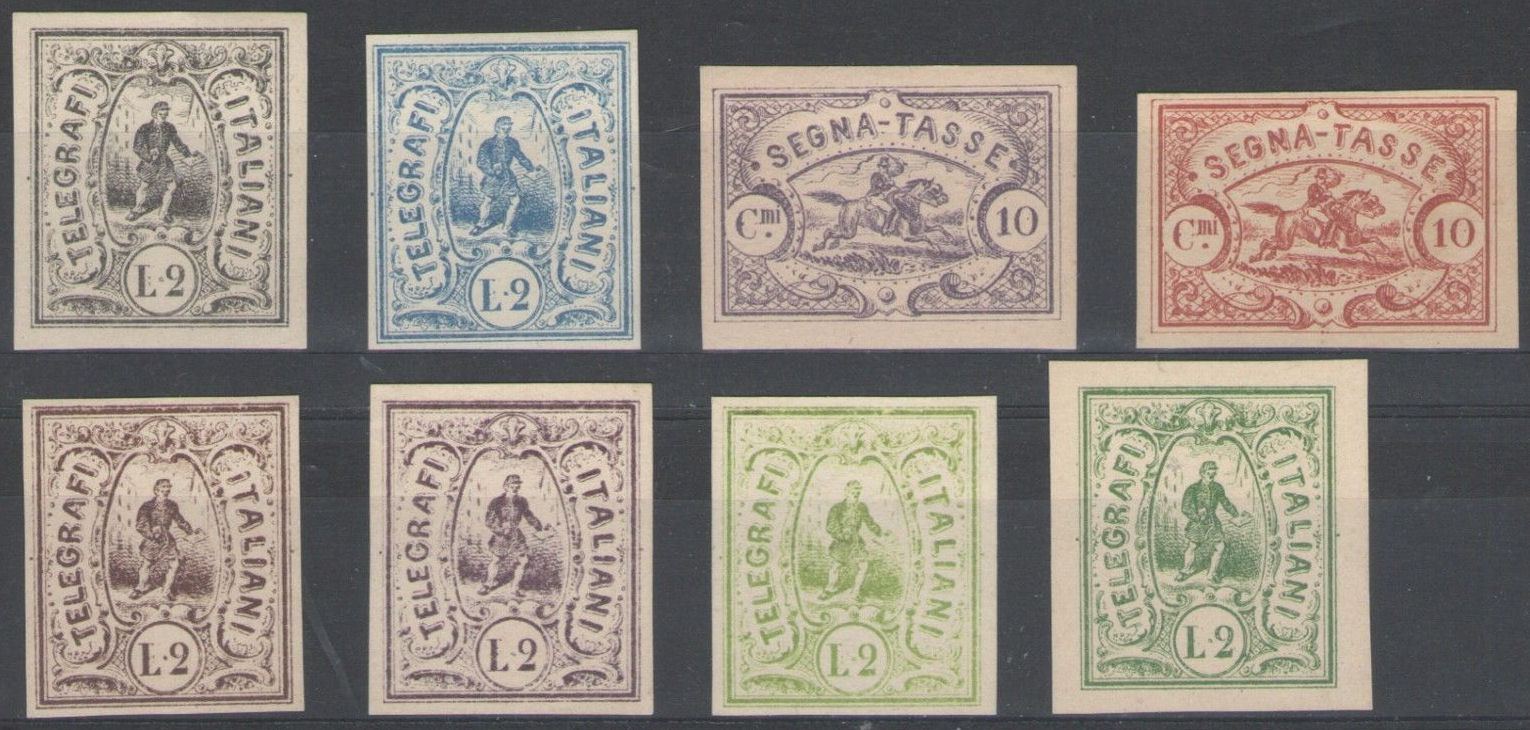
Courtesy Philippo Elia (romablusplendid on eBay). ("SEGNA TASSE" means Postage Due, so not telegraphic but part of the same eBay lot)
The certificate from Caffaz Perito Filatelico says in Italian:
ITALIA 1864: saggi "H... (Torino)" di francobollo per telegrafo non adottati, in colori diversi: 2L. nero,
2L. azzurro oltremare, 2L. rosso mattone, 2L. rosso carminio, 2L. bruno, 2L. violetto, 2L. verde giallo
e 2L. verde scuro "FATTORINO ENTRO CORNICE CON SCRITTE AI LATI", stampa litografica,
emessi in foglietti di 8 esemplari su carta spessa giallognola, non dentellati, senza gomma. (Bol. encicl. S XV)
(*) Non si è in grado di fornire il nominativo del tipografo (probabilmente torinese) che allesti questi saggi.
Nelle documentazioni esaminate viene sempre e solo citato come Signor "H" - [hand-written Hummel]
A mio parere le prove qui fotograficamente riprodotte sono originali e sono perfette. Le ho firmate "Caffaz".
In English, this translates (with the help of Yahoo) as:
ITALY 1864 essays "H. .. (Turin)" unadopted telegraph stamp in different colors: 2L. Black,
2L. ultramarine, 2L. red brick, 2L. carmine, 2L. brown, 2L. violet, 2L. yellow-green
and 2L. dark green "BELLBOY IN FRAME WITH WRITING AT THE SIDES", lithographic printing,
issued in sheets of 8 copies on thick yellowish paper, imperf, without gum. (Bol. Encyc. S XV)
(*) It was not possible to provide the name of the printer (probably in Turin) who prepared these essays.
In the documents examined is only ever referred to as Mr. "H" - [hand-written Hummel]
In my opinion the evidence photographically reproduced here, are original and are perfect. Signed "Caffaz".
I would like to hear from any Italian speakers that can confirm or correct my translation.
Images courtesy Philippo Elia (romablusplendid on eBay). Click on image to see listing.
|
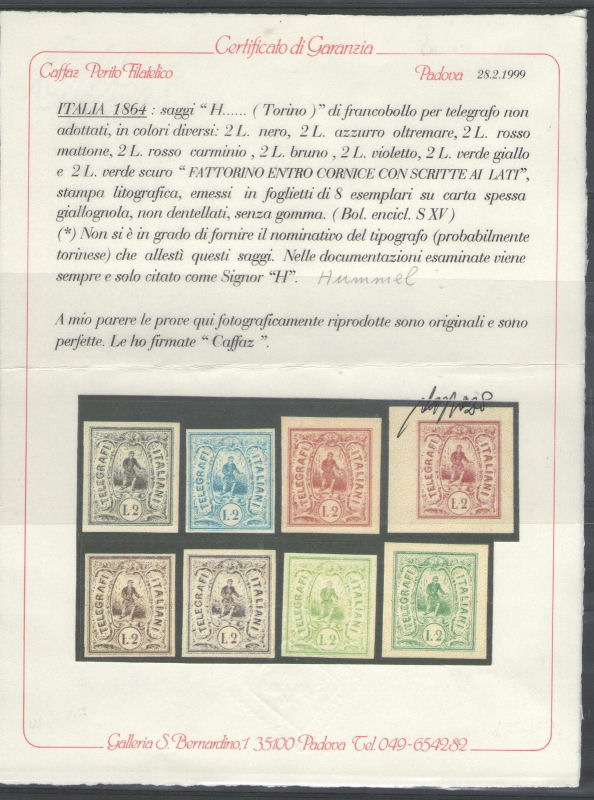 |
Three more shades, courtesy of Andrew Higson.
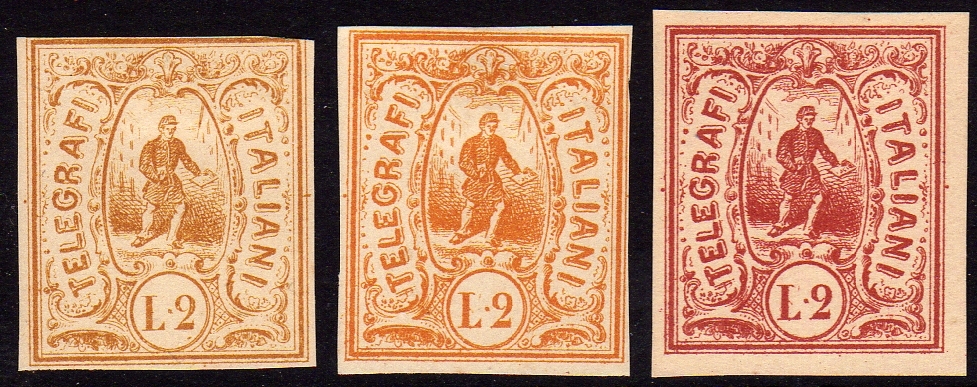
The Kingdom included a large area between Northern Italy and France, as well as the Island.
All images in this section are courtesy of Andrew Higson.
Only essays/proofs/trials are known. 1857?
Numerals and script in either black, grey-black, red or gold on various coloured papers and backgrounds, with or without embossing.
Some of the papers are thick, bordering on cardboard, but the majority are thin. The embossing is the same as that used for postage stamps of the 1850's.
See the warning at the bottom before spending money on these.
Plain coloured paper.
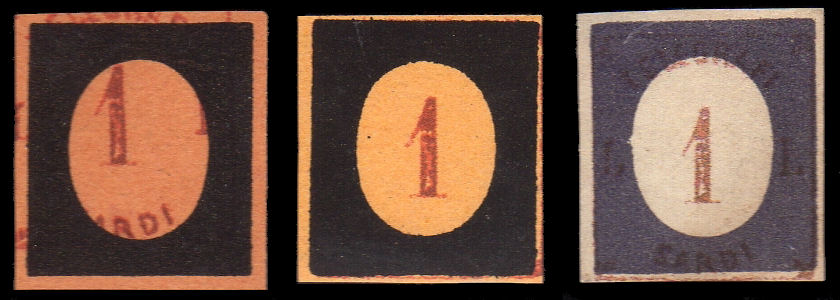

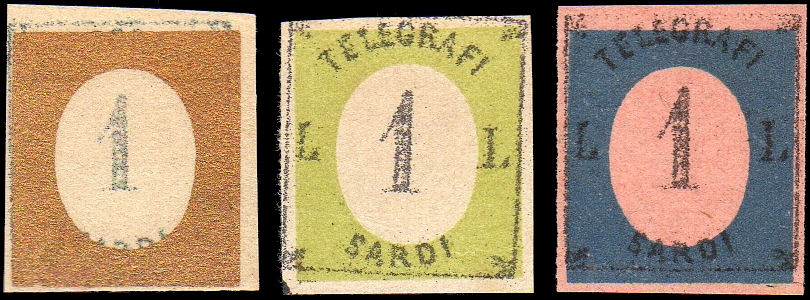
Embossed.

Numerals and script in black or grey-black.

Numerals and script in black or grey-black. Note that the last has a smaller 'overprint'.
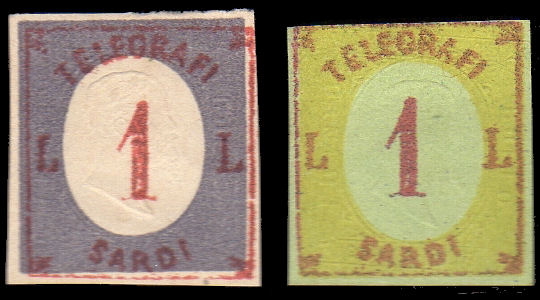
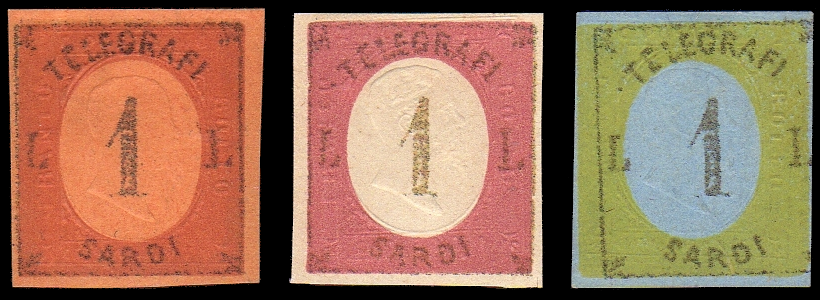
Numerals and script in red or gold.
The embossing on these appears to be the same as the 1850's stamps of the Kingdom of Sardinia produced by Françoise Matraire (Turin) -
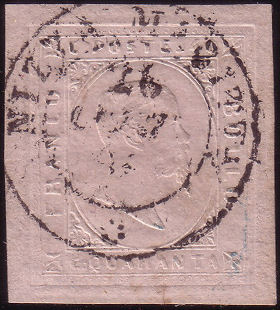
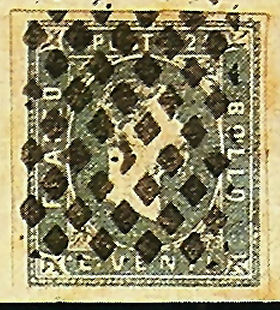
The embossing includes the face values at the bottom. On the left is a 40c (Quarenta), on the right a 20c (Venti).
The King of Sardinia became the King of Italy on 17 March 1861. See above.
Warning
It should be noted that the new owners of Françoise Matraire's business sold off its archives in the early 1900's.
This included printer’s waste and un-embossed sheets.
See in particular this Forum.
Further information is needed on the status of these.
Stationery.
Modello 41
A Modello 41 telegram printed 4 March 1866 and used in Bologna 1868 for a 6-word telegram from nearby Imola.
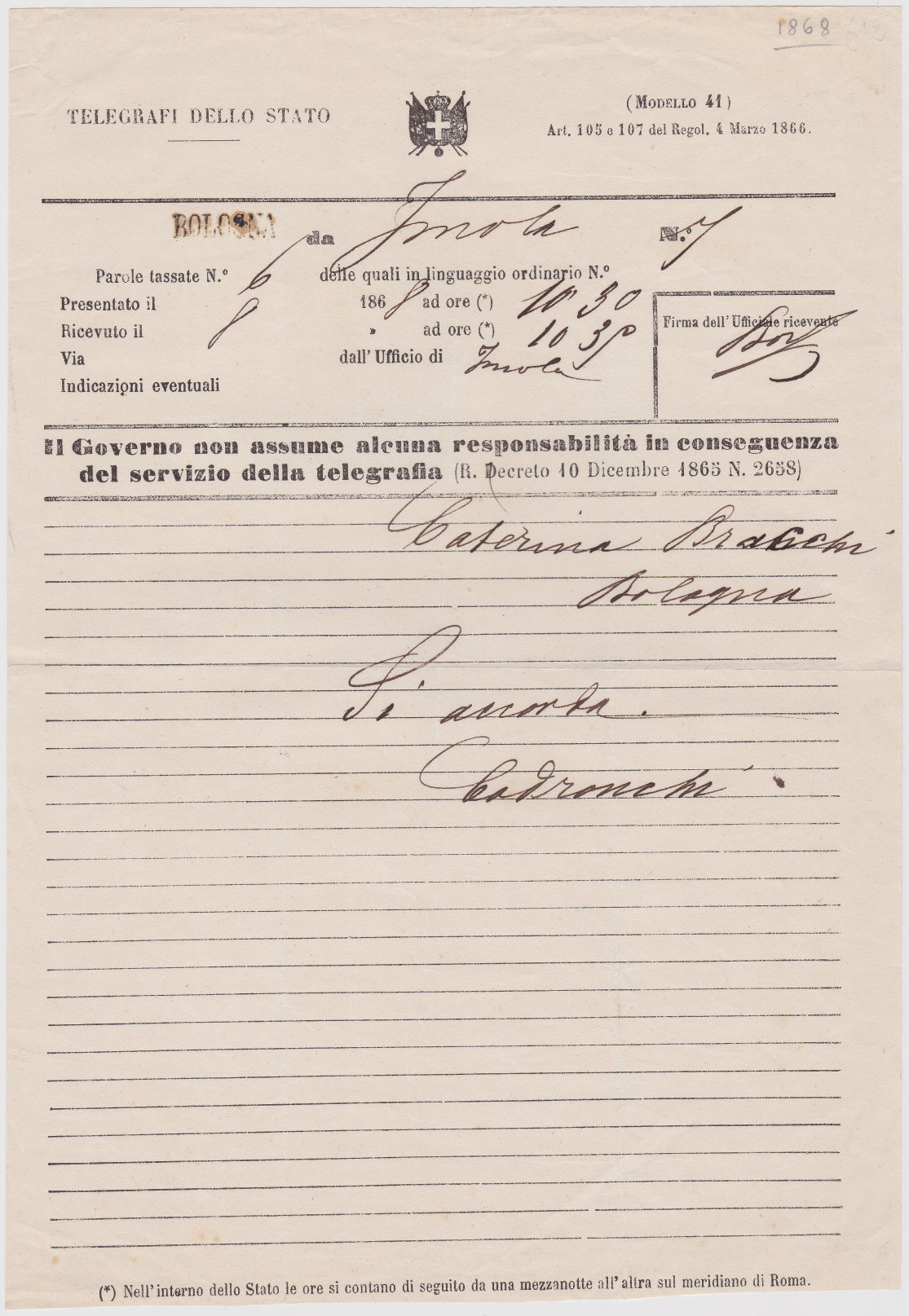
Times are according to Rome time.

This telegram would have needed an envelope for sending, see below.
For a while, envelopes were used.
1858 (14 September) Used in Forli with a Roman local stamp.
This also as a Forli Telegraph cachet with the Papal Arms (as on the stamp).
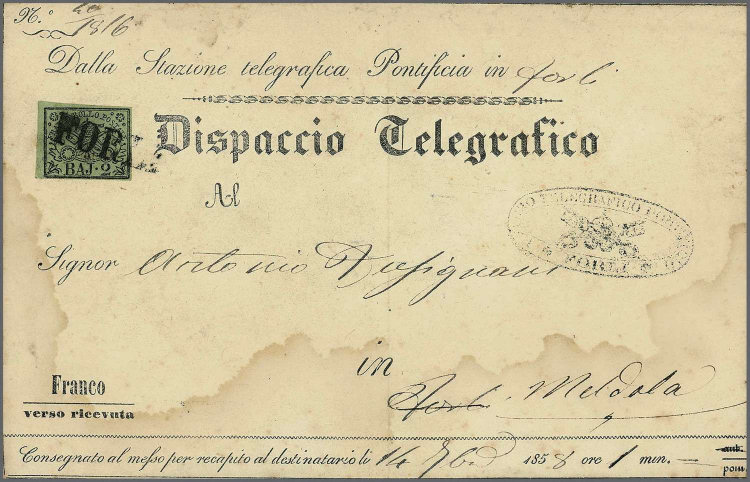
Image courtesy of Fabrizio Ferrari.
1865 (4 August) Used in Ischia with 50c in Postage. Stamped "Raccomandato", perhaps meaning "Registered".
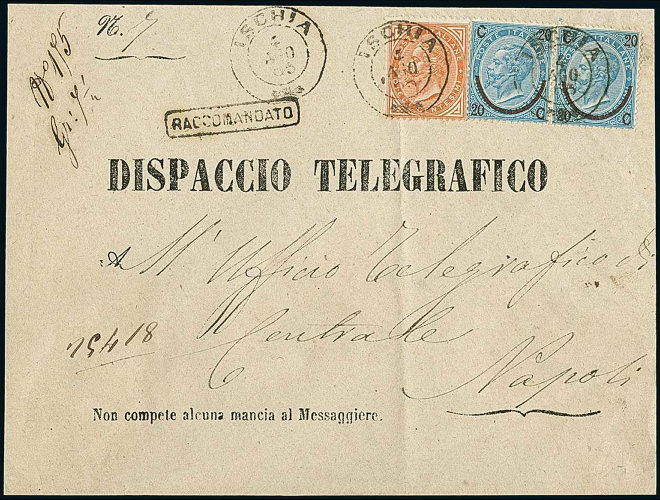
"Non compete alcuna mancia al Messaggiere." (There is no tip to the Messenger.) at the bottom.
Image courtesy of Fabrizio Ferrari.
1869 (19 September) Used in Firenze (Florence) with 10c Postage Due stamp. This has "Mod. 114", the form number at top-right.
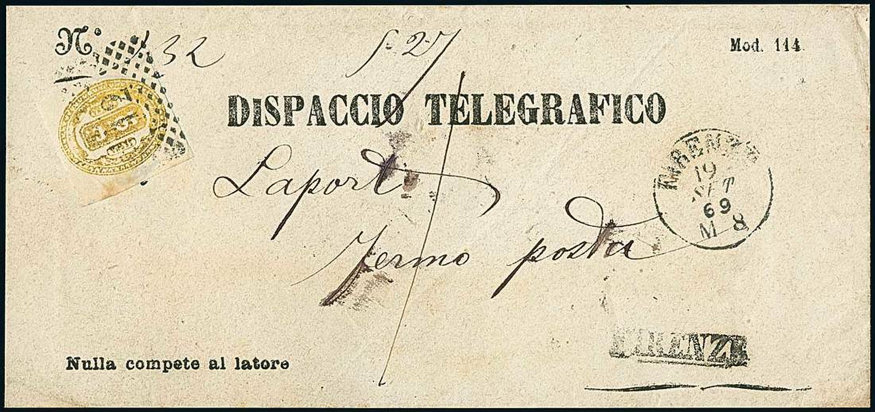
"Nulla compete al latore." (Nothing is due the bearer ?) at the bottom.
Image courtesy of Fabrizio Ferrari.
Later flaps were added to the telegrams and envelopes were not needed.
A telegram of 1881 to Verona.
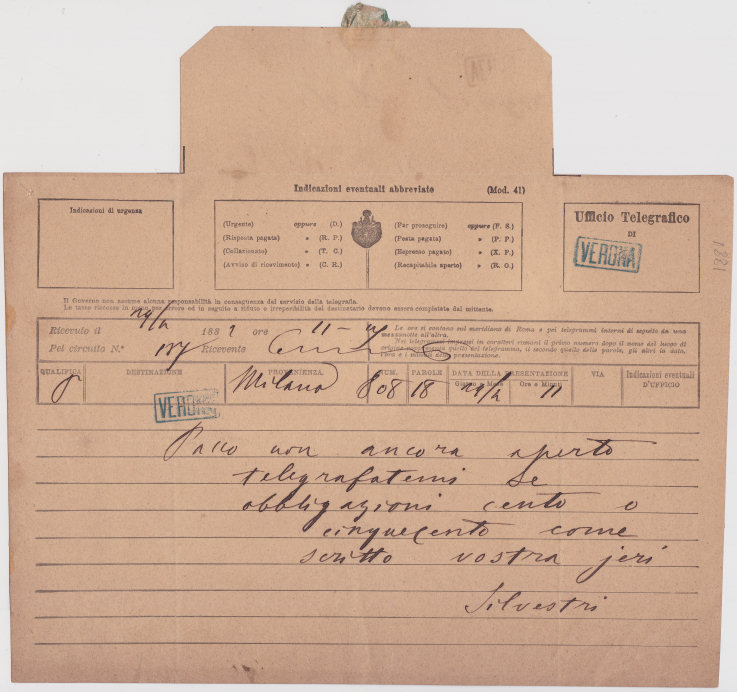
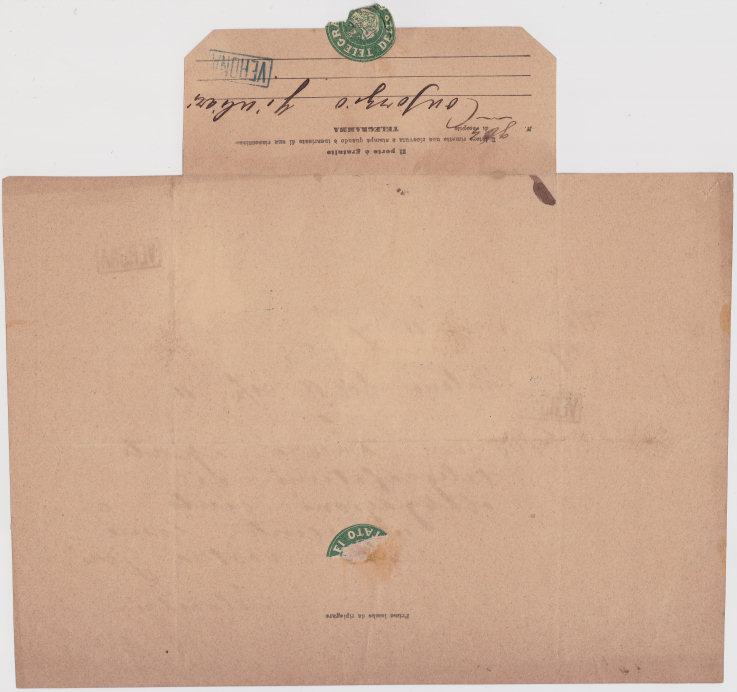
On later types, flaps were added so that the telegram can be folded, an address and seal added, and then sent free without an envelope or stamps.
From about 1910, perforations were added to the flaps to make opening easier. |
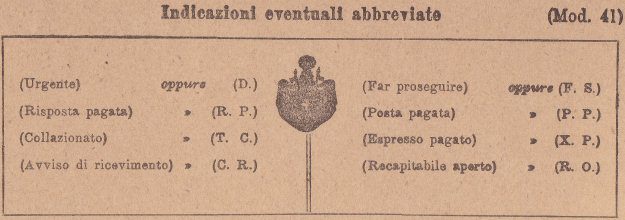 |

 |
When scanning these telegrams, due to size, the flap is usually left closed,
covering the Form number (Mod. 41or later 30), and abbreviations.
The pre-filled year can be helpful.
The back is mostly blank, but it does say "Primo lembo da ripiegare"
or later "Primo lembo da piegare", telling people to fold the flaps. |
A telegram of 1882 (quarter size)
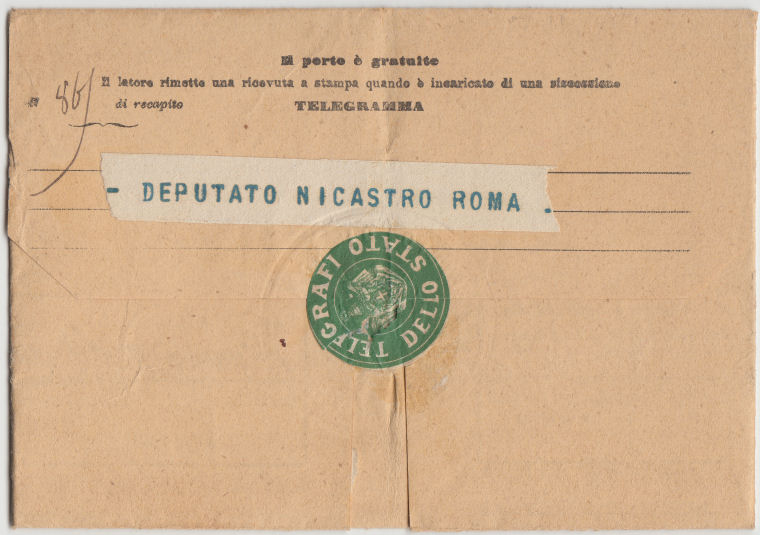 |
|
Telegram Seals.
For about 30 years, Italy used seals to close telegrams.
Then, like a number of other countries, they used telegrams with built-in gummed flaps.
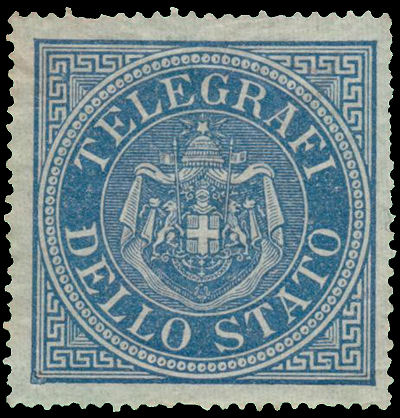
Steve Hiscocks made a start on cataloguing seals of the world in a book he published
in 2007. It was his hope to update it later, but unfortunately that was not to be.
You can view my attempt at an update here : Latest page for Italy.
|
Modello 30
A Modello 30 telegram used in Verona in 1884. The top-right box is labelled "Ufficio Telegrafico DI". Some of the later ones are different.
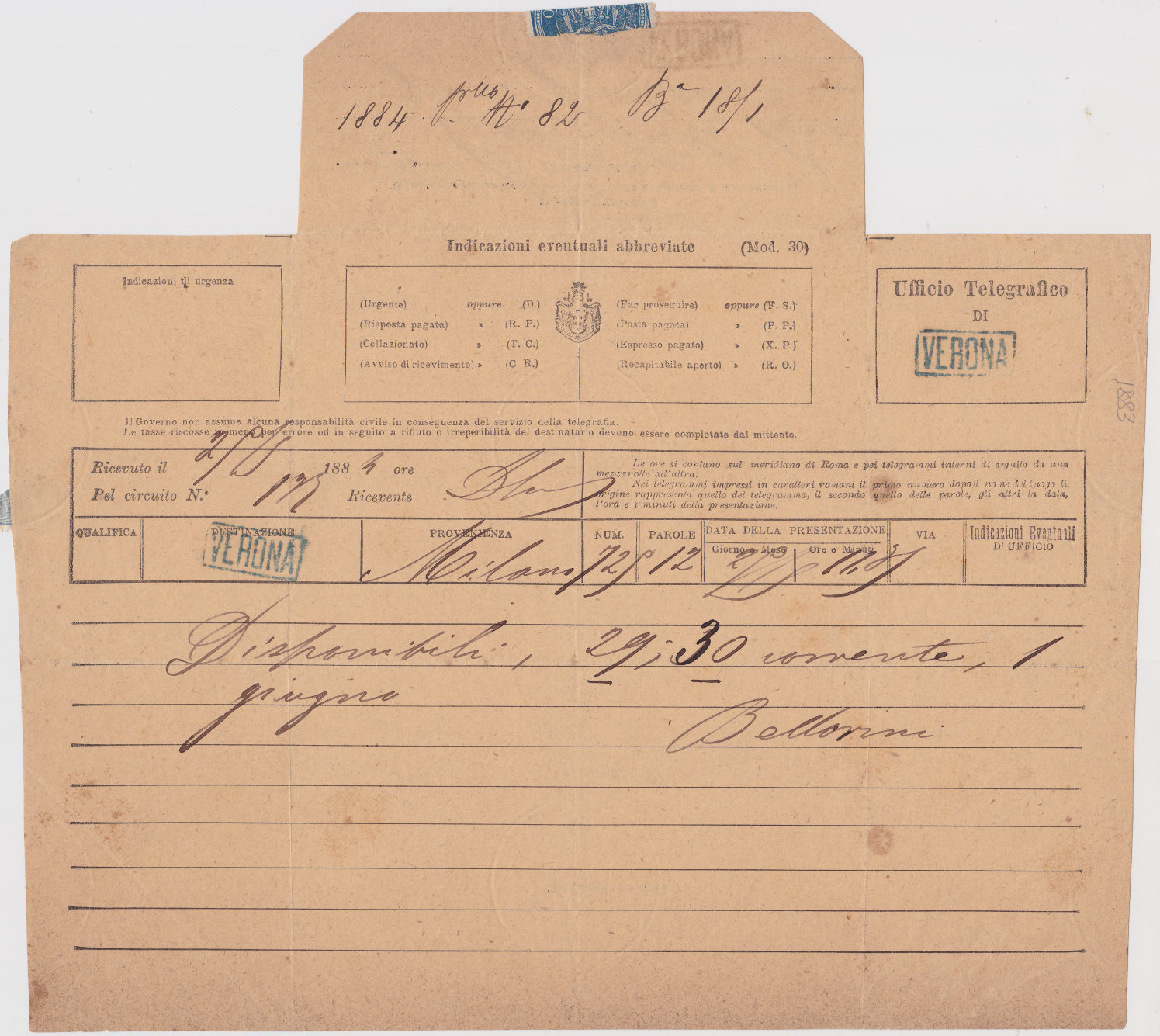
This telegram looks identical to the last shown Modelo 41 type, except for the Modelo number !
A Modello 30 telegram used in Rome in 1886.
The box at the top-left corner now has a line under "Indicazioni di urgenza"
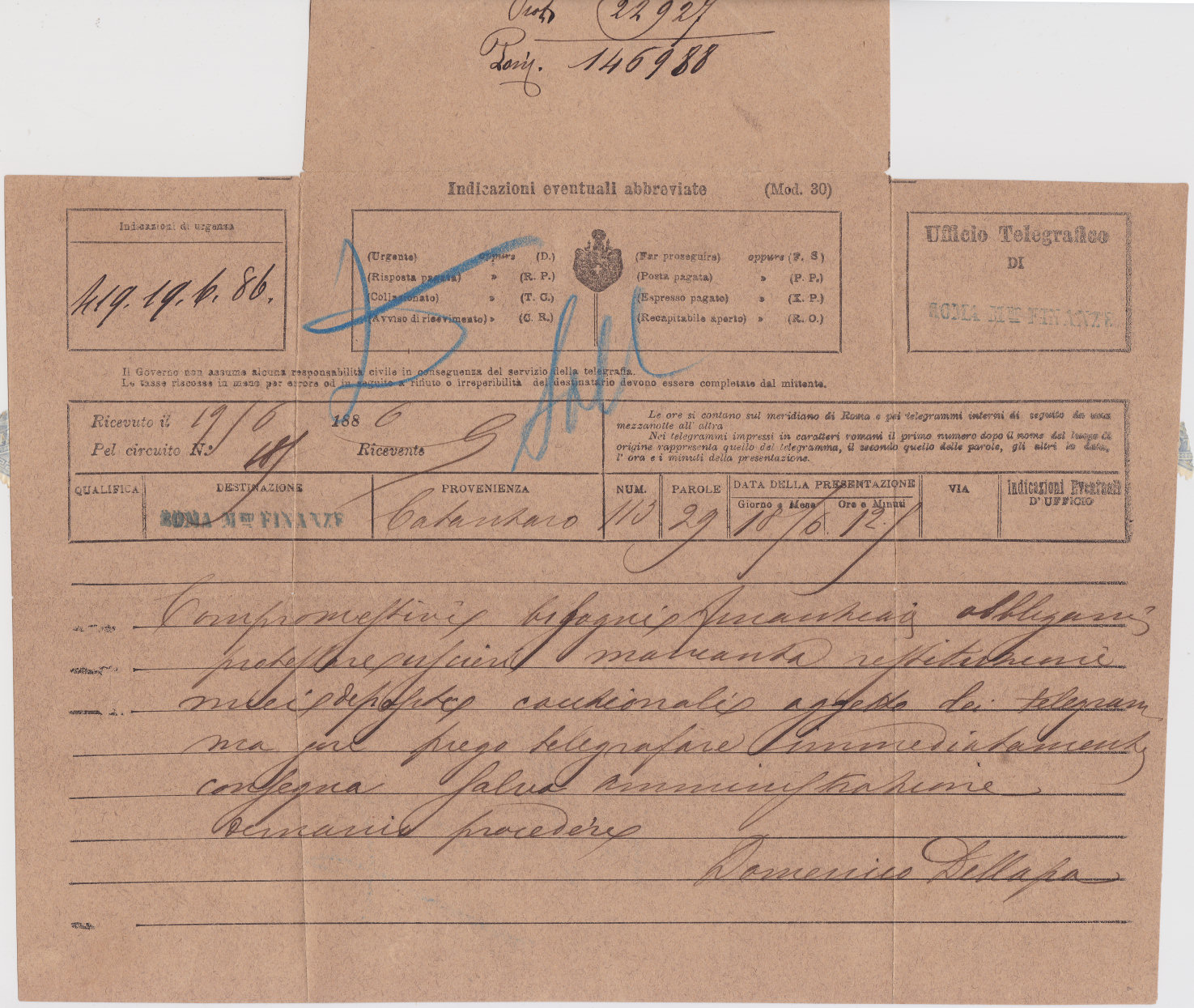
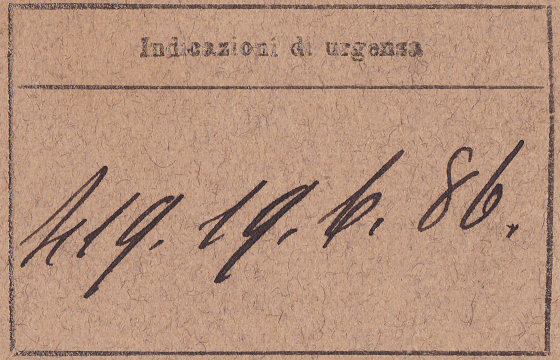
Now a clear change, but still Modelo 30 type.
A Modello 30 telegram used in Corigliano Calabro in 1890 (the pre-filled 188 has been altered).
The list of abbreviations has gained RPD and PR. It ia also much clearer, even the Coat of Arms is legible (better paper).
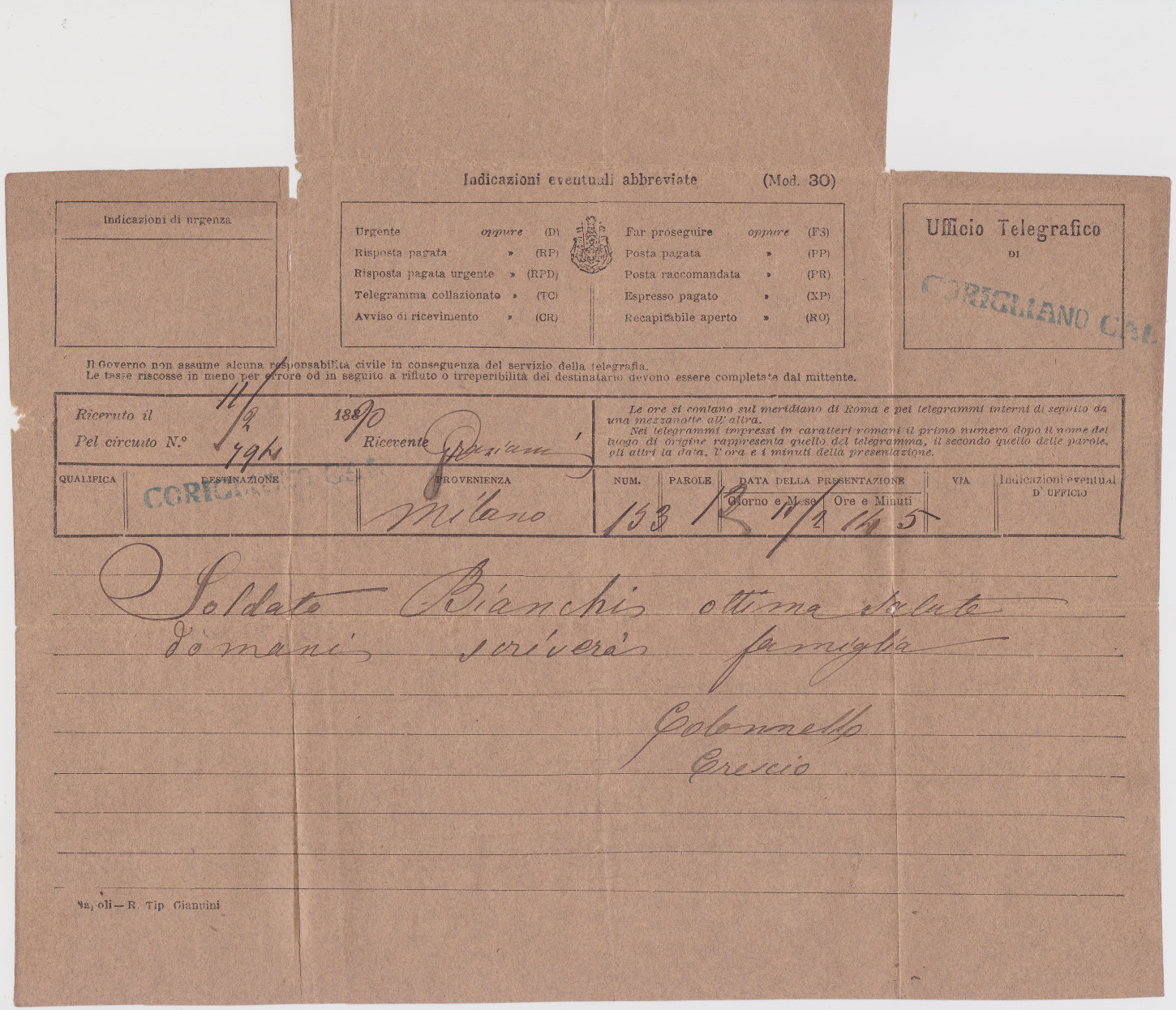
The list of abbreviations has gained RPD and PR. It ia also much clearer, even the Coat of Arms is legible (better, darker paper). Still Mod. 30 though.
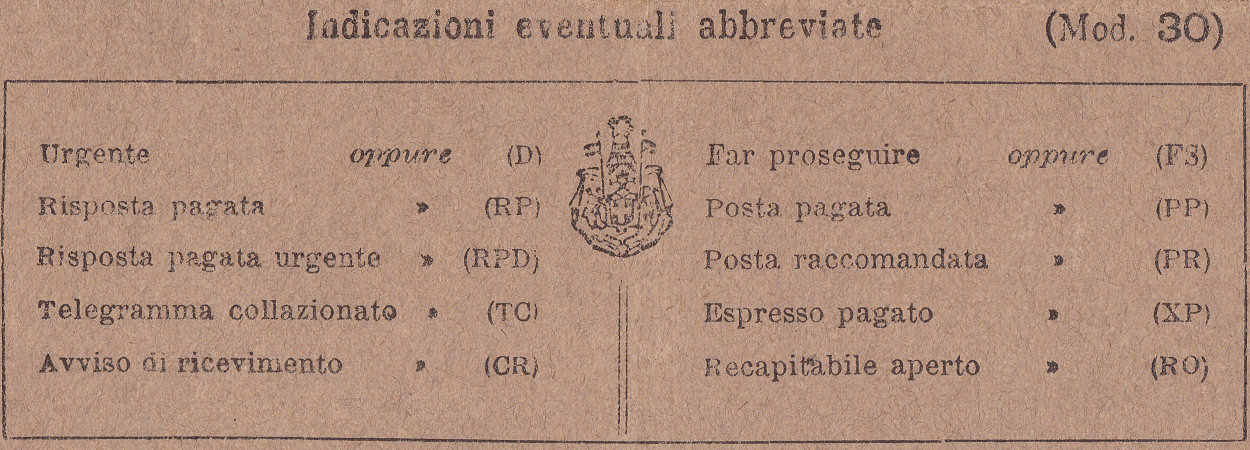

Now an imprint for Gianuini of Naples.
A Modello 30 telegram used in Verona in 1891 (now pre-filled date of 189_).
The top-right box is labelled with "Ufizio" rather than "Ufficio".
The list of abbreviations has gained many more.
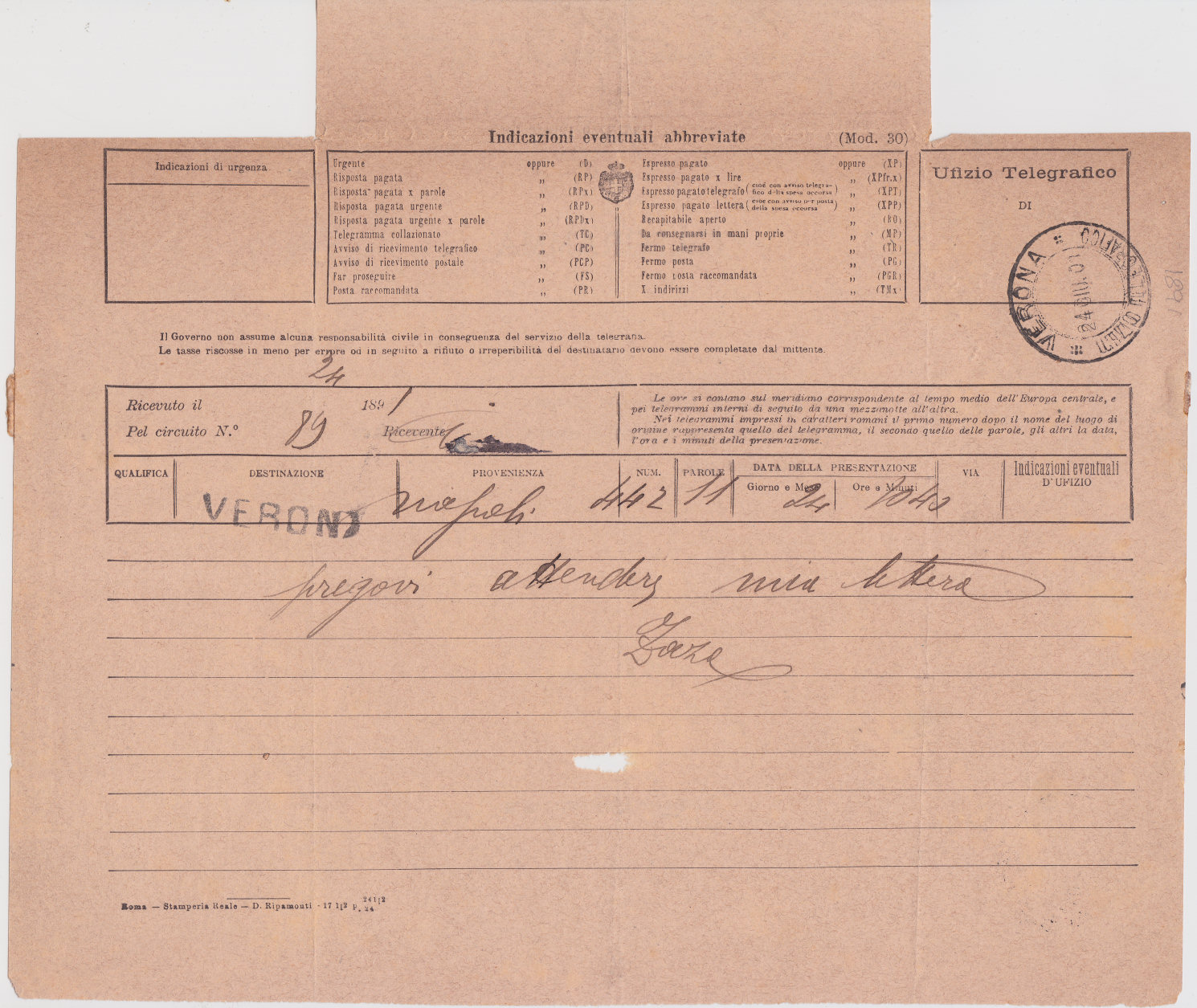
The list of abbreviations has gained many more). Still Mod. 30 though.



The Year is prefilled now with "189". Now the bottom-left has an imprint of Rome. "Stamperia Reale" = Royal Printing House. With the name D. Ripamonti and a string of numbers.
The flap now has a perforated section and the outside is marked "TELEGRAMMA", and "Nulla è dovuto al fattorino pel recapito.
Il latore rimette una ricevuta a stampa quando è incaricato di una riscossione." meaning "Nothing is due to the delivery man.
The complainant shall print a receipt when charged with collection."
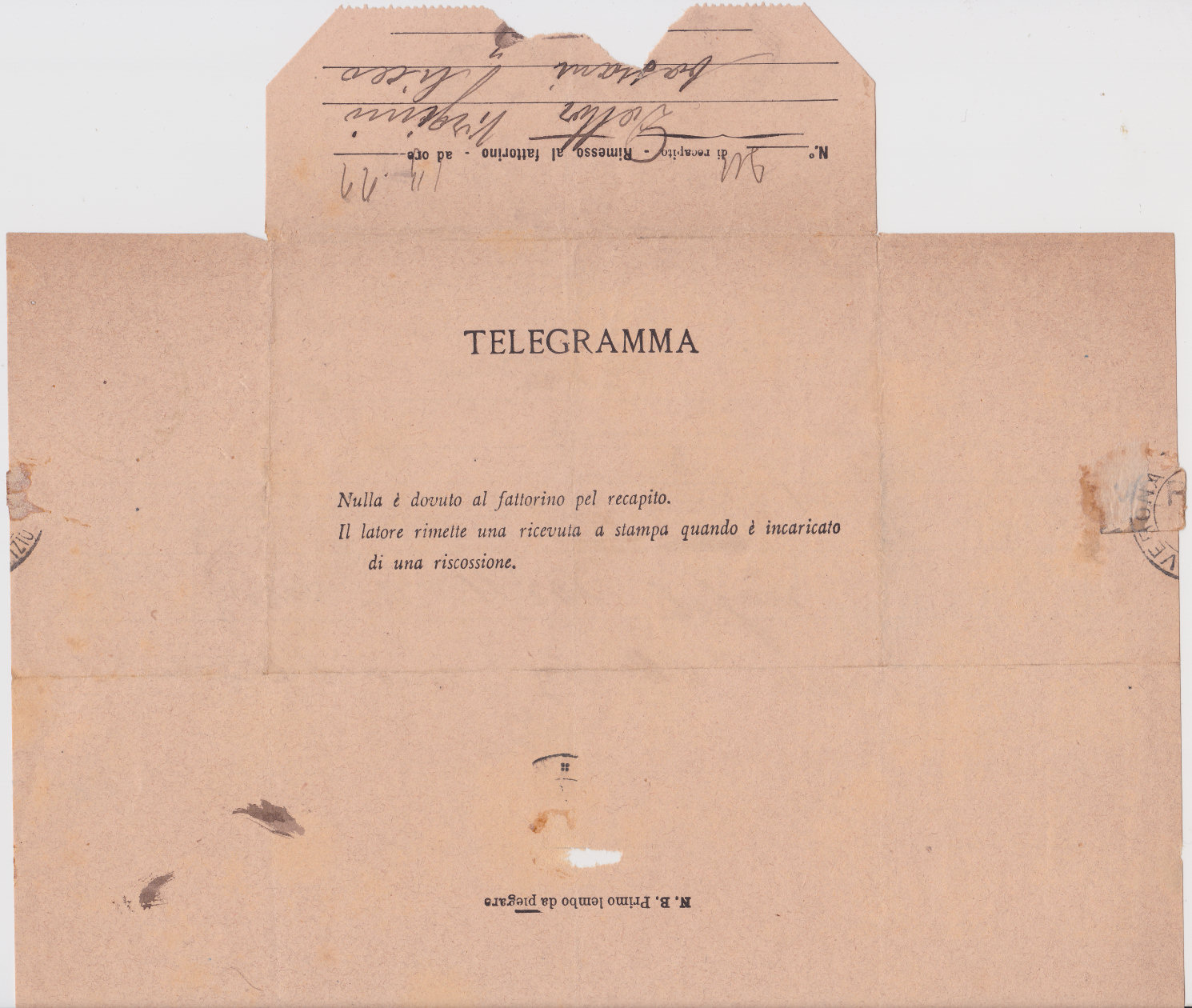
Another vertually identical Modello 30 telegram used in Verona Central in January 1907.
The paper is different. The year is pre-filled with "190".
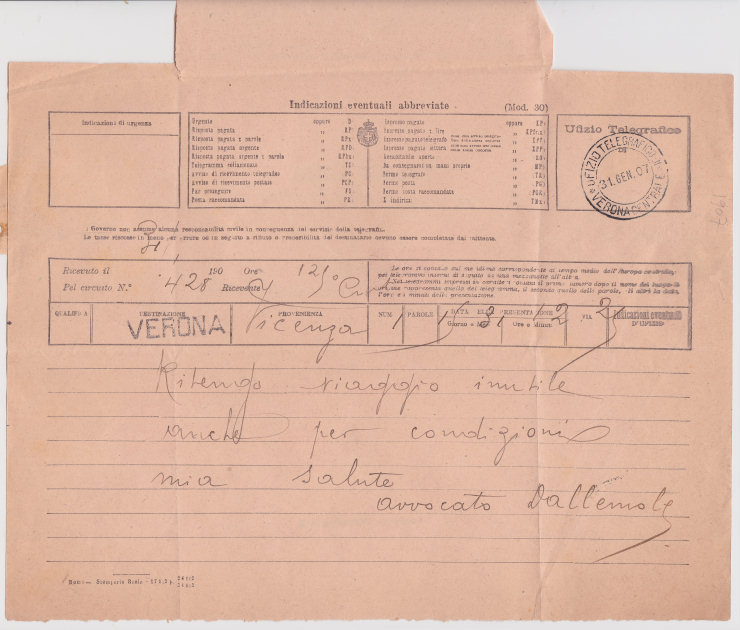

The main difference is the imprint that no longer references D. Ripamonti and has some duplication of the numbers.

This is from a similar telegram used in Verona Central on the same day in 1907.
This though included D. Ripamonti in the imprint.

I include it because it clearly shows the way the flap was perforated on these.
This is from a form used in 1913? The Coat of Arms has moved down and the form has been rearranged
The year is now pre-filled with "191".
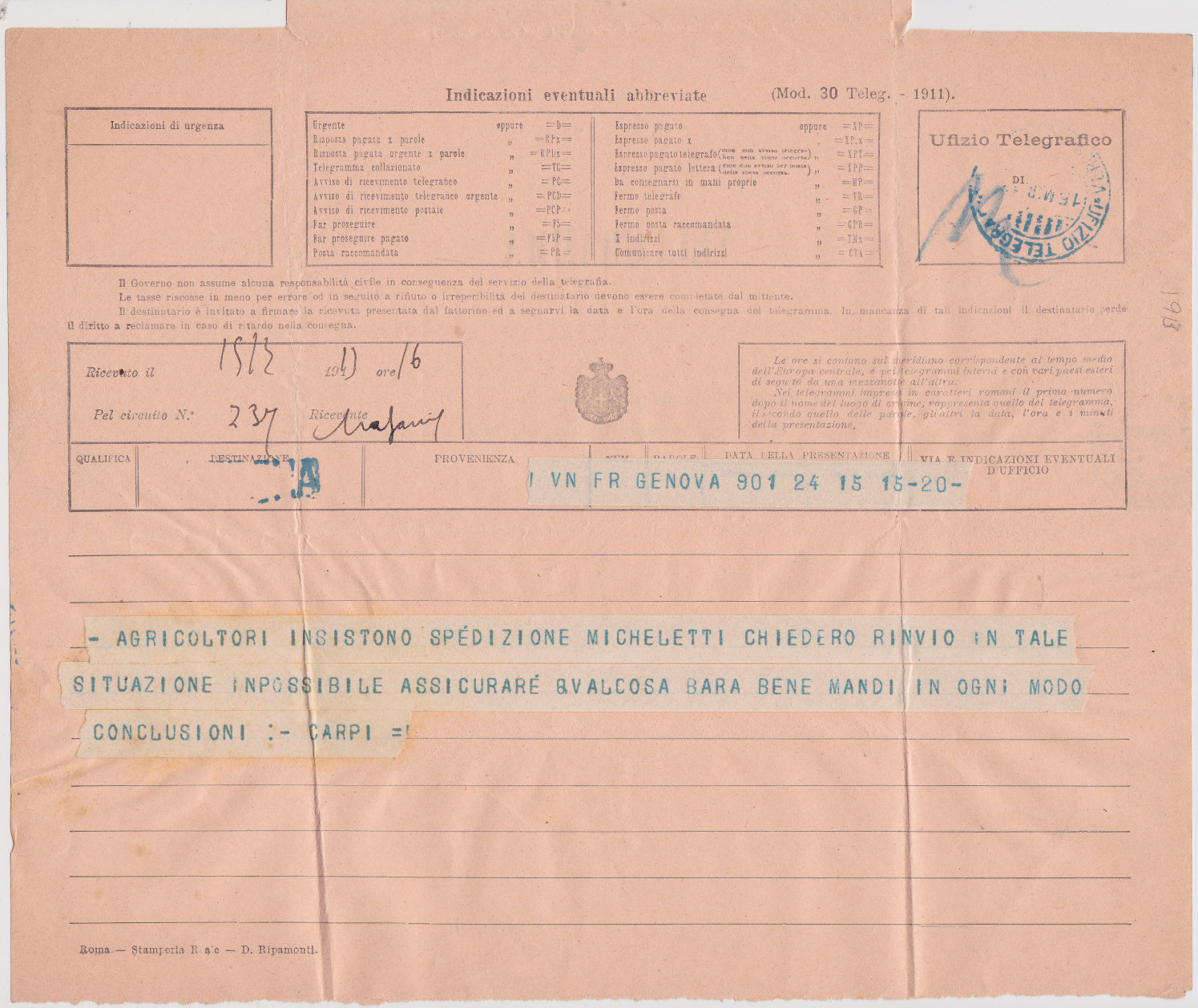
D. Ripamonti is back on the imprint at the bottom, without the string of numbers. The Form number is now "(Mod. 30 Teleg. - 1911)." much more informative.

New imprint at the bottom-left.

This is from a form used in 1917. It is very similar to the last but has no imprint at the bottom.
The flap perforations have changed to a narrower section. The top-right box is now back to "Ufficio".
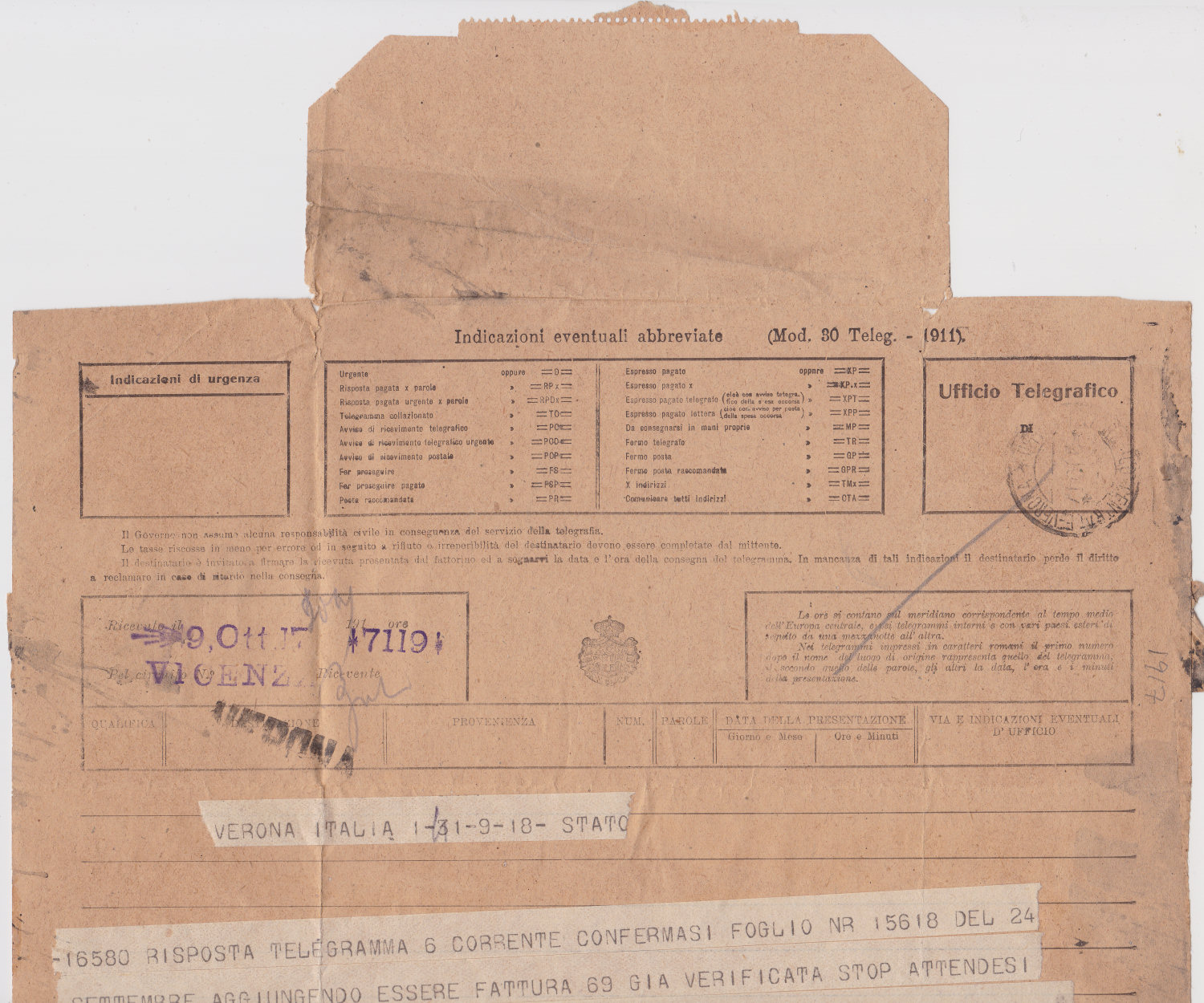
This has no imprint at the bottom, but the Form number is still "(Mod. 30 Teleg. - 1911)."

The back shows how the perforated section was used to seal it after folding.
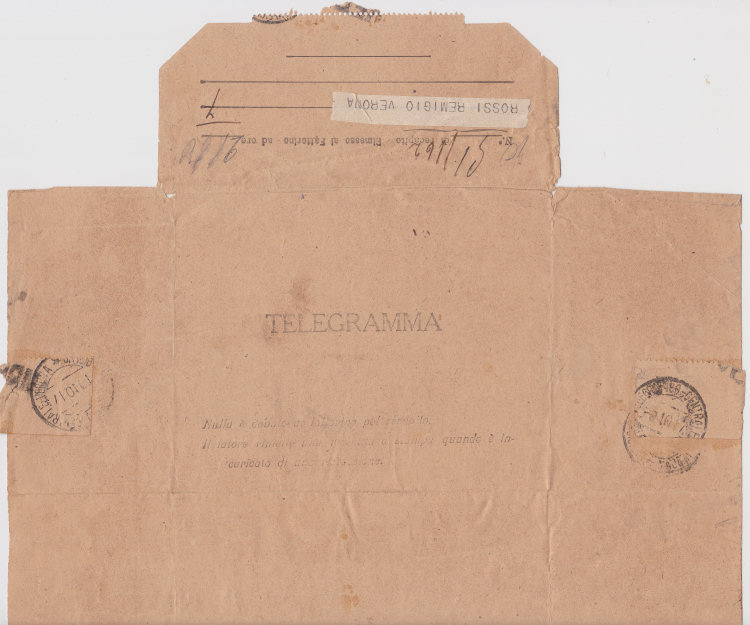
This is a form used in December 1923 in Verona. It is very similar to the last but has an extra line at the bottom, a different imprint and date.
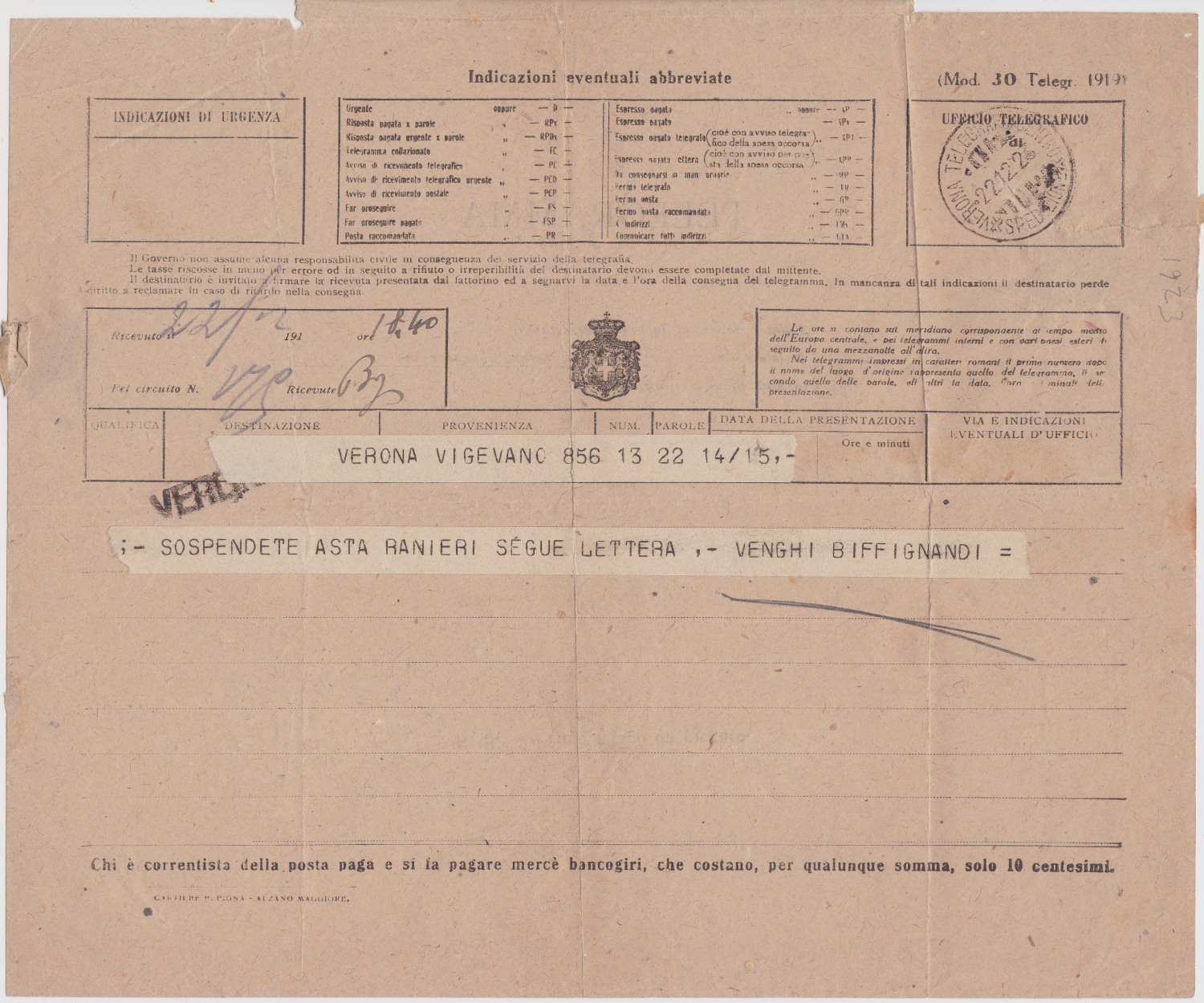
It has added "Chi è Correntista della posta paga e si fa pagare mercè bancogiri, che costano, per qualunque somma, solo 10 centesimi." at the bottom.
The Form number is now "(Mod. 30 Telegr. 1919)".

The bottom has a new imprint. Pigna is a district of Rome. Alzano Maggiore is in Lombardy.

This is a form used in 1923 in Ferrara (northeastern Emilia-Romagna region). It has a different imprint and date and the year is pre-filled as "192".
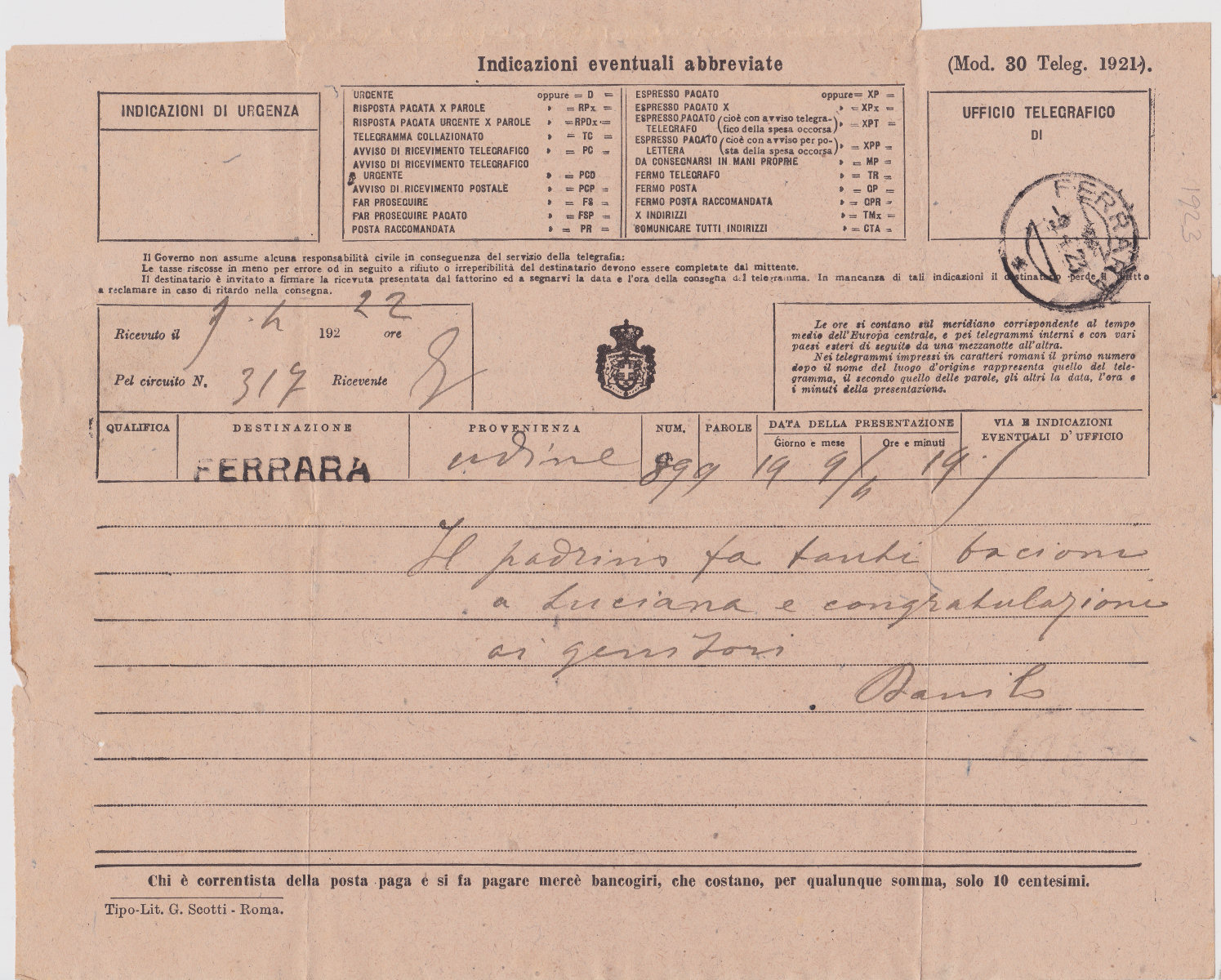
The Form number is now "(Mod. 30 Teleg. 1921)".

The bottom has a new imprint. Lithographed by G. Scotti of Rome.

This is a form used in 1924 in Verona. It is just like the last except the imprint has been Capitaized.
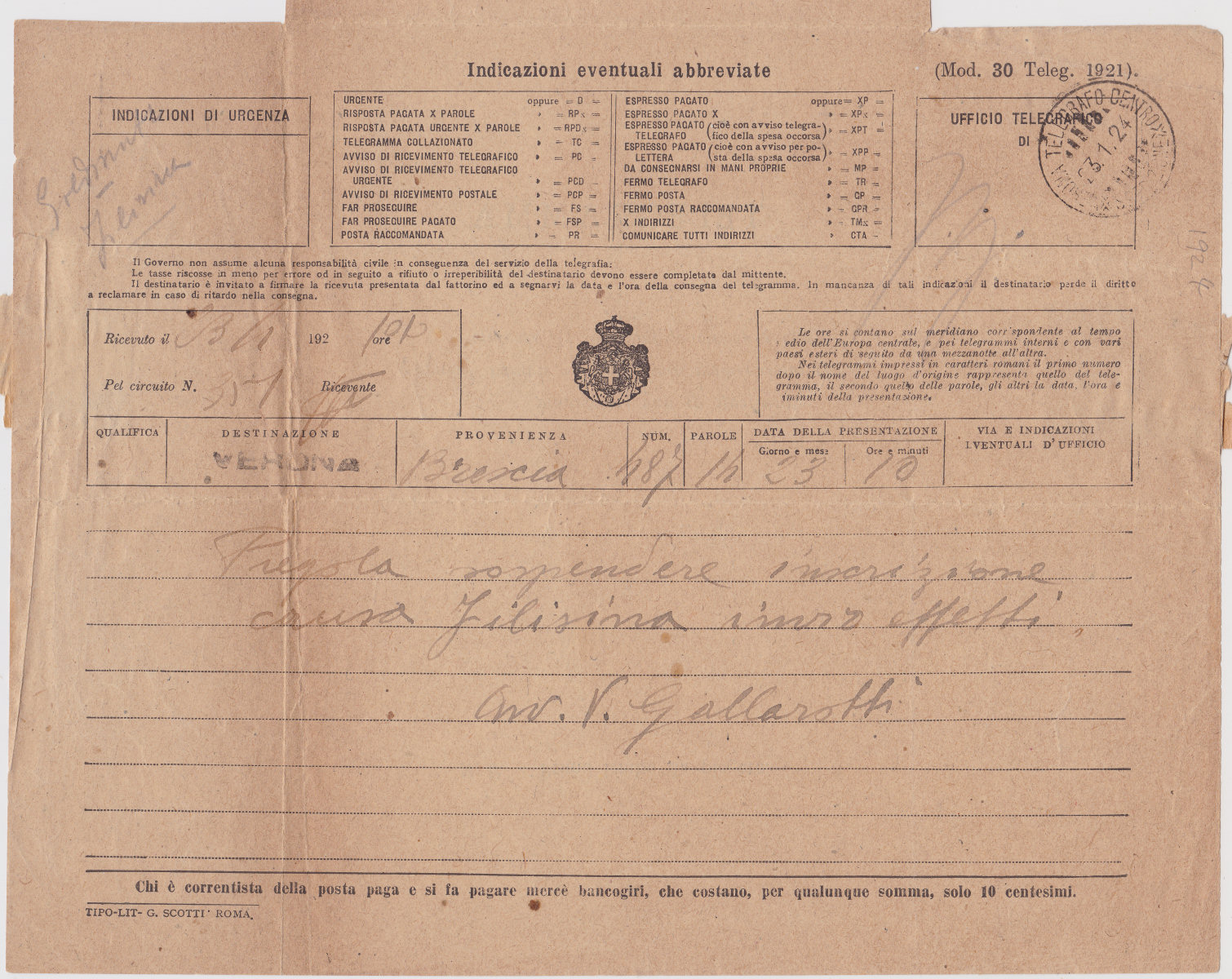
The Form number is now "(Mod. 30 Teleg. 1921)".

The bottom imprint is now G. SCOTTI ROMA (Capitalized).

This is a form used in 1937 in the Commune of Paluda (Padua near Venice). It has a number of differences.
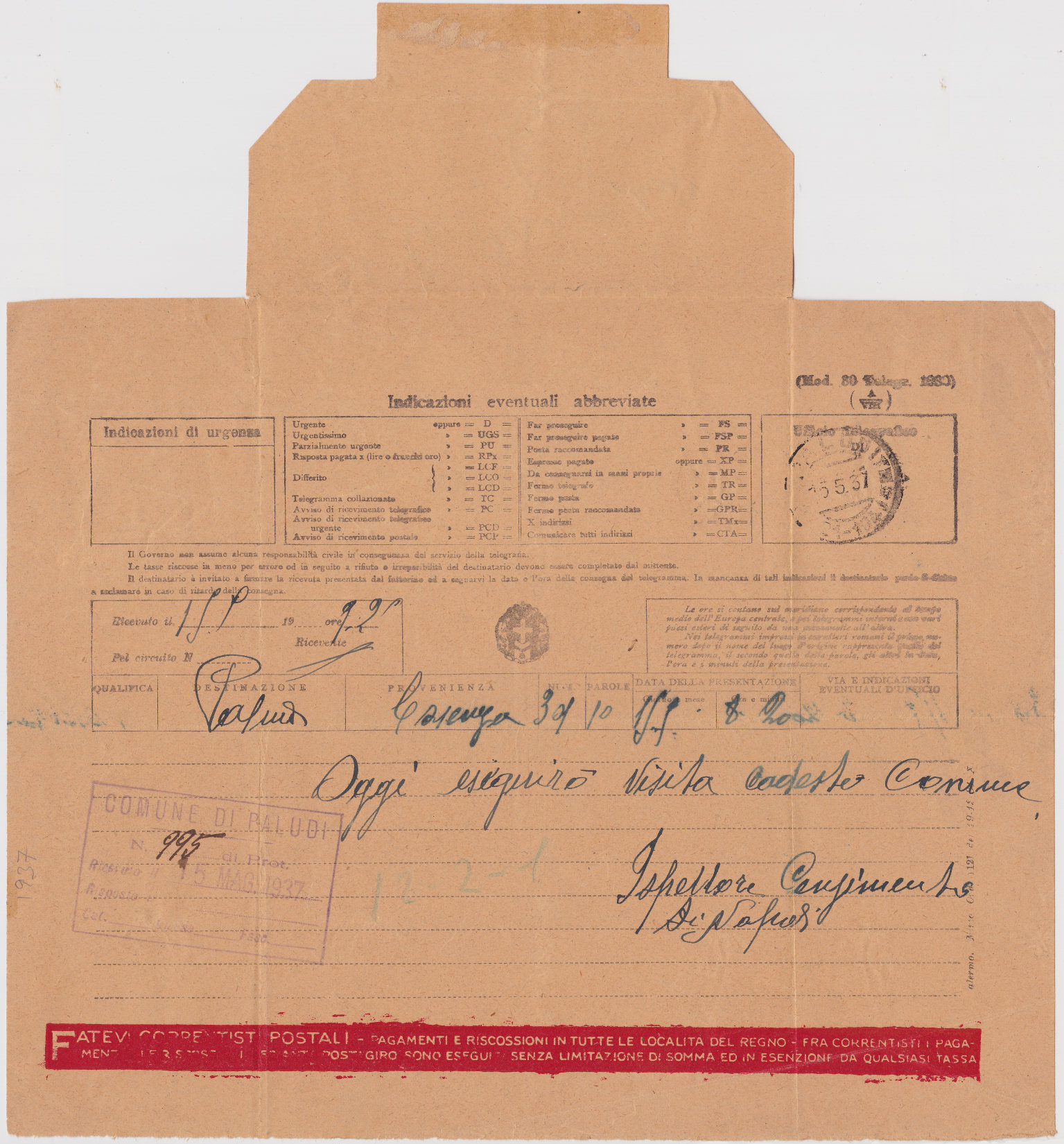
In red at the bottom looks like "FATEVI CORRENTISTI POSTALI - PAGAMENTI E RISCOSSIONI IN TUTTE LE LOCALITA DEL REGNO - FRA CORRENTISTI I
PAGAMENT (?????) POSTAGIRO SONO ESEGUI SENZA LIMITAZIONE DI SOMMA ED IN ESENZIONE DA QUALSIASI TASSA", meaning (I think)
"Be a Postal Account holder - Payments and Collections in all locations of the Kingdom - between account holders and Payment (?????) Postal Giro are executed without limitation of sum and exempt from any tax"
The abbreviations have changed quite a lot :

The Form number is now "(Mod. 30 Telegr. 1930)"
with a bracketed A / VTK (I think)

The imprint on the lower right side is also hard to read, but looks like printed in [P]alermo 19-12-31 (or perhaps 34).

The back is fairly standard :
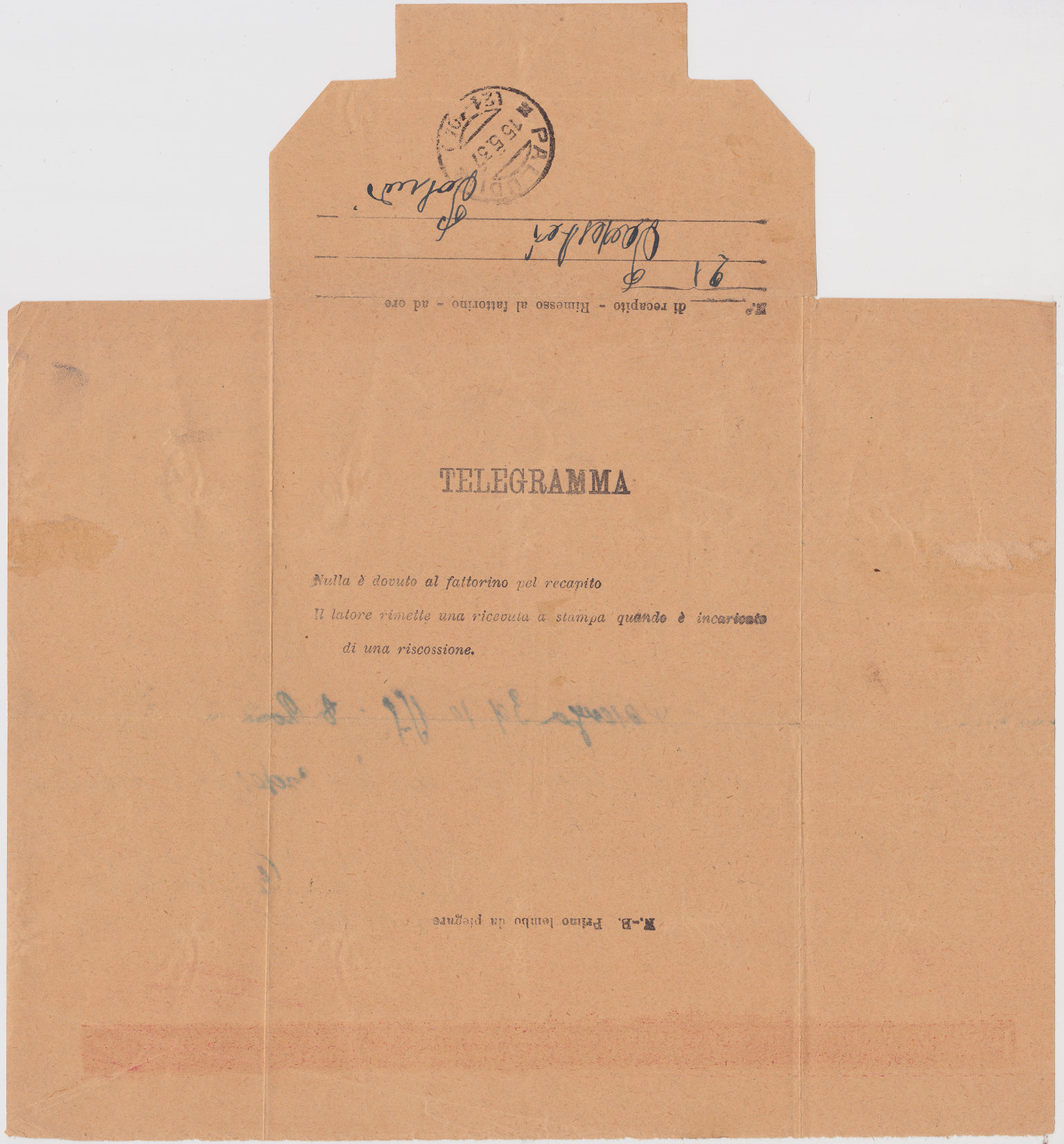
This is a form used in March 1939 in Rome. It is re-arranged to incorporate advertising on both sides. The abbreviations are gone, but still Mod. 30.
The advertising seems to have been organised by a place in Milan. The (unused) pre-filled year is now "193", and the imprint is at top-right.
The text on the left reads : "Per queste publicliè rlvolgersi ISTITUTO NAZIONALE PER LA PROPAGANDA Via degil Ardill, 1 - MILANO - Telefono 70-921"
meaning "For these publications, please contact NATIONAL INSTITUTE FOR PROPAGANDA Via dègil Ardill, 1-MILAN-Phone 70-921".
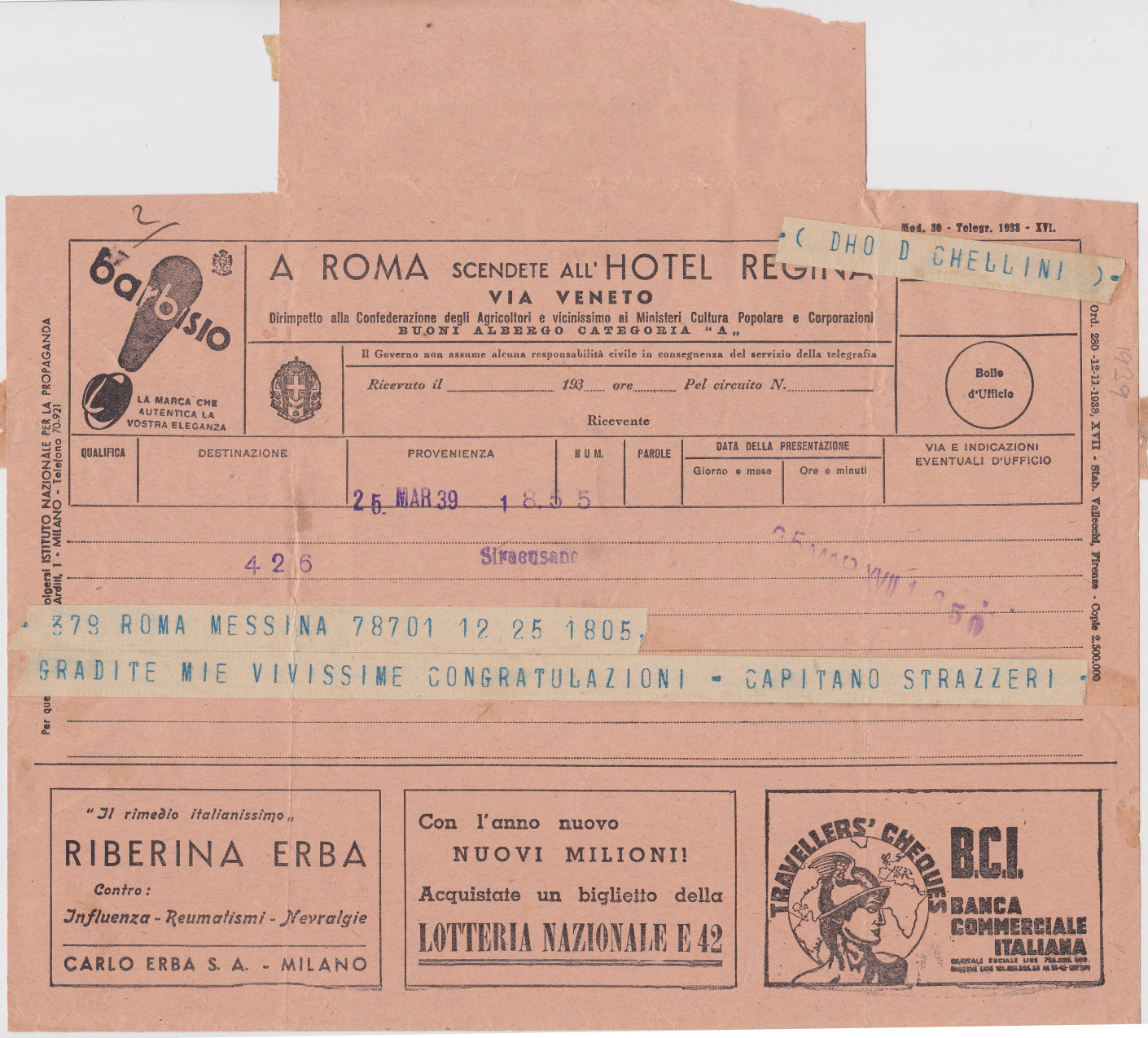
The Form number is now "(Mod. 30 Teleg. 1921)".

The bottom imprint is now Vallecchi of Firenze (Florence), dated 12-11-1938 indicating 2,500,000 copies printed.

The back is also used for advertising.
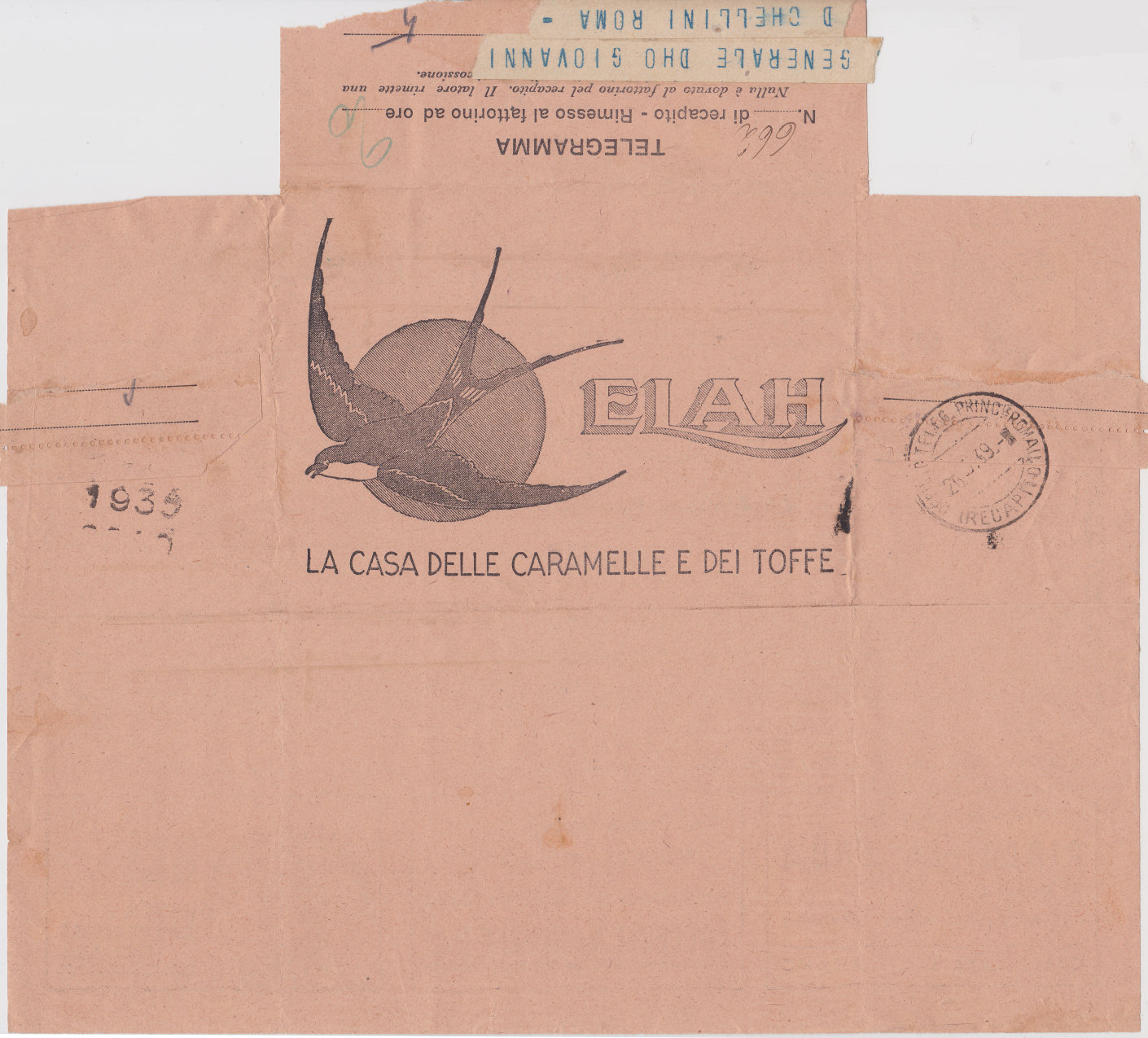
Modello 30-A
This is a similar form for use in Naples that is designed to be folded and sealed without a flap. Form number and imprint are at the bottom.
No abbreviations. No pre-filled year. This was used on 3 March 1908.
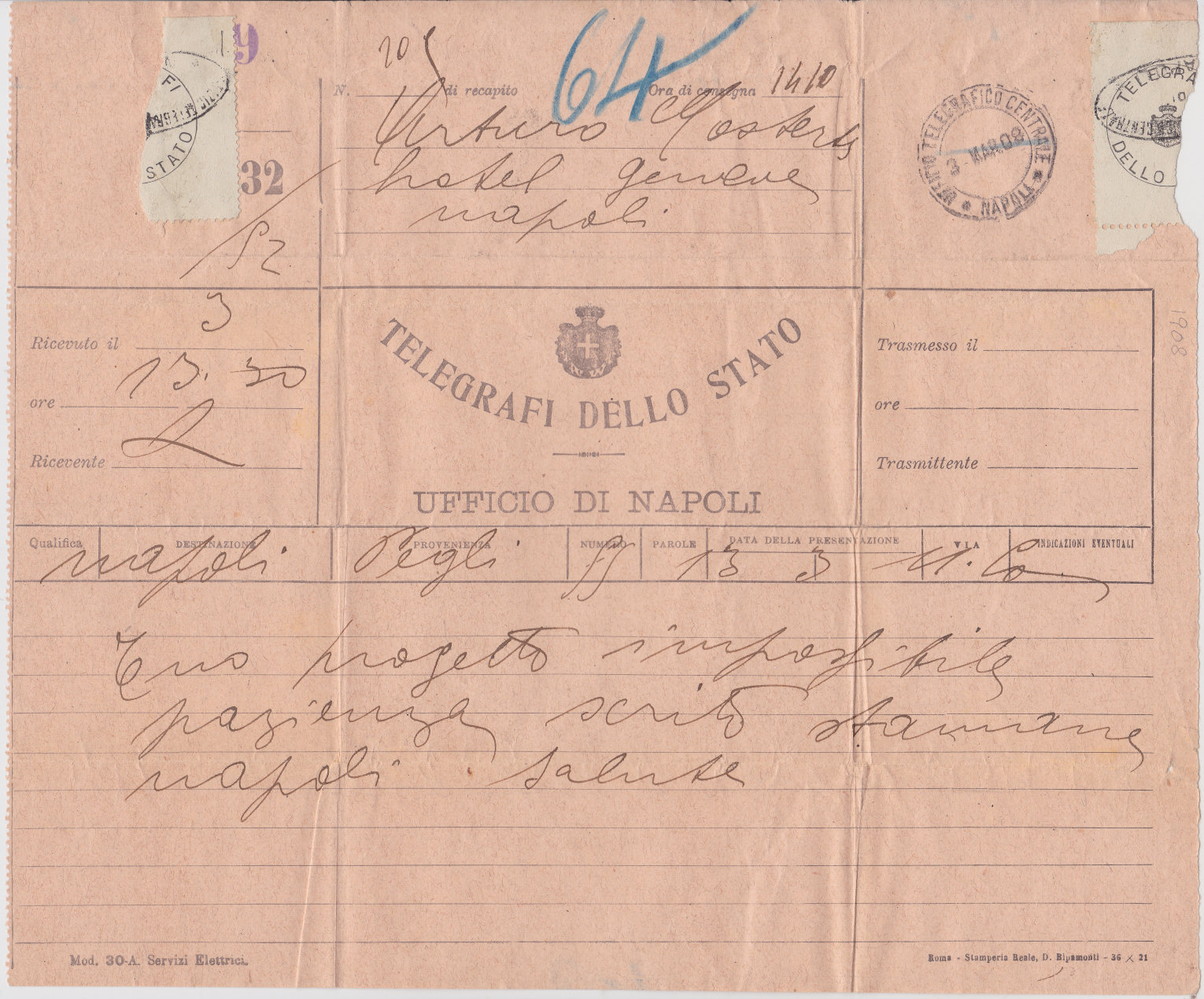
The Form number is now "Mod. 30-A. Servizi Elettrici." (Electrical Services)

The bottom imprint is the familiar D. Ripamonti of the Royal Printers, Rome, but with added "36 x 21".
Whilst the height is 21 cm, the width is 25½ cm, suggesting a 10½ cm stub on the left side.

Modello 25
This form has "Modello 25." at the top and has an attached receipt for 19 words. It was used in Verona on 9 September 1904. that is designed to be folded and sealed without a flap. Form number and imprint are at the bottom.
Abbreviations appear to be in the panel on the left. Pre-filled year is "190".
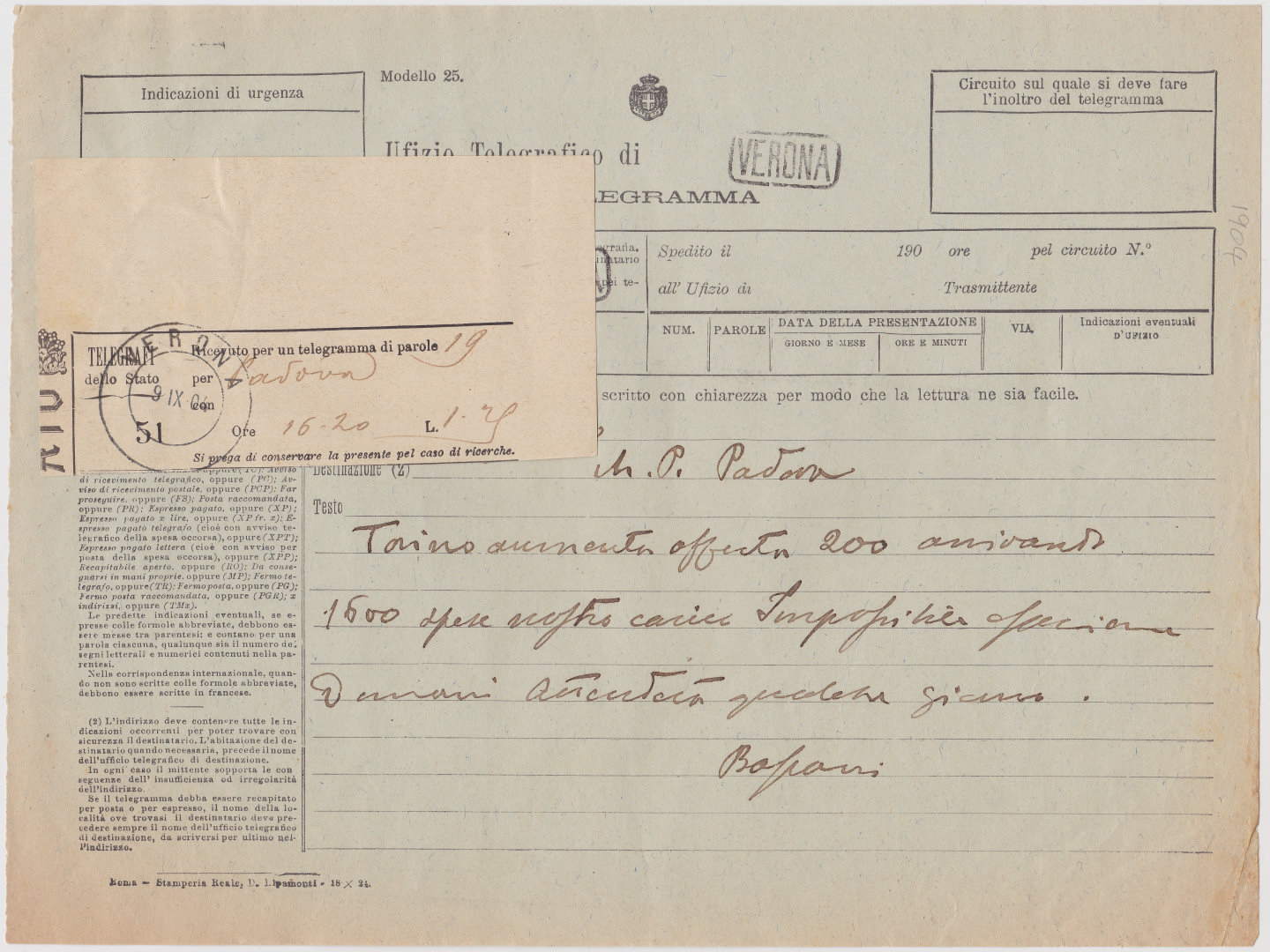
The bottom imprint is the familiar D. Ripamonti of the Royal Printers, Rome, but with added "18 x 24",
reflecting the form height of 18 cm and width of 24 cm.

A telegraph Form used 1958 in Verni Lucca (Tuscany). Front and back, quarter size, courtesy of Andrew Higson.
Form number at top-right: MOD. 25 (Ediz. 1955)
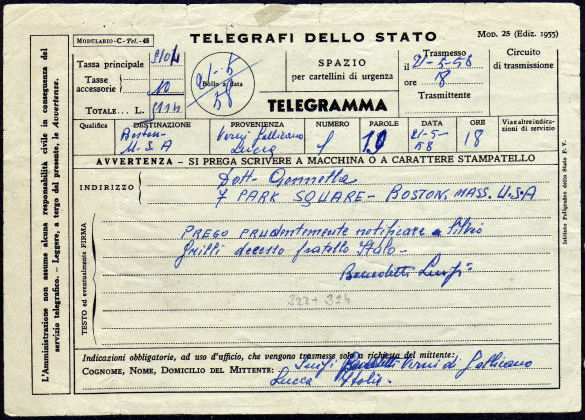
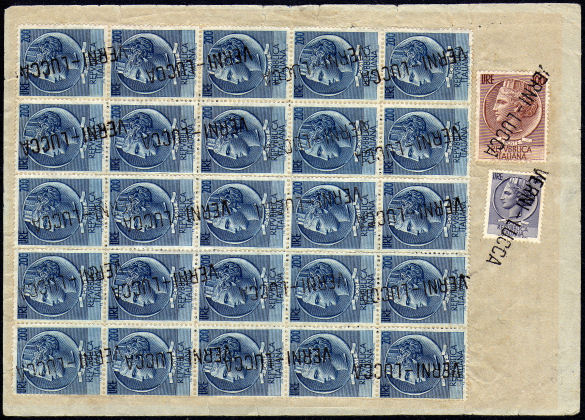
| The front top-left has : |
 |
, top-right : |
 |
, up right side : |
 |
As with telegraph forms in a lot of countries, a lot of stamps were needed.
The L200 was the highest face value from December 1954. In 1957, L500 and L1000 stamps were released.
Easy to guess why.
Here is a similar unused one from 1975:
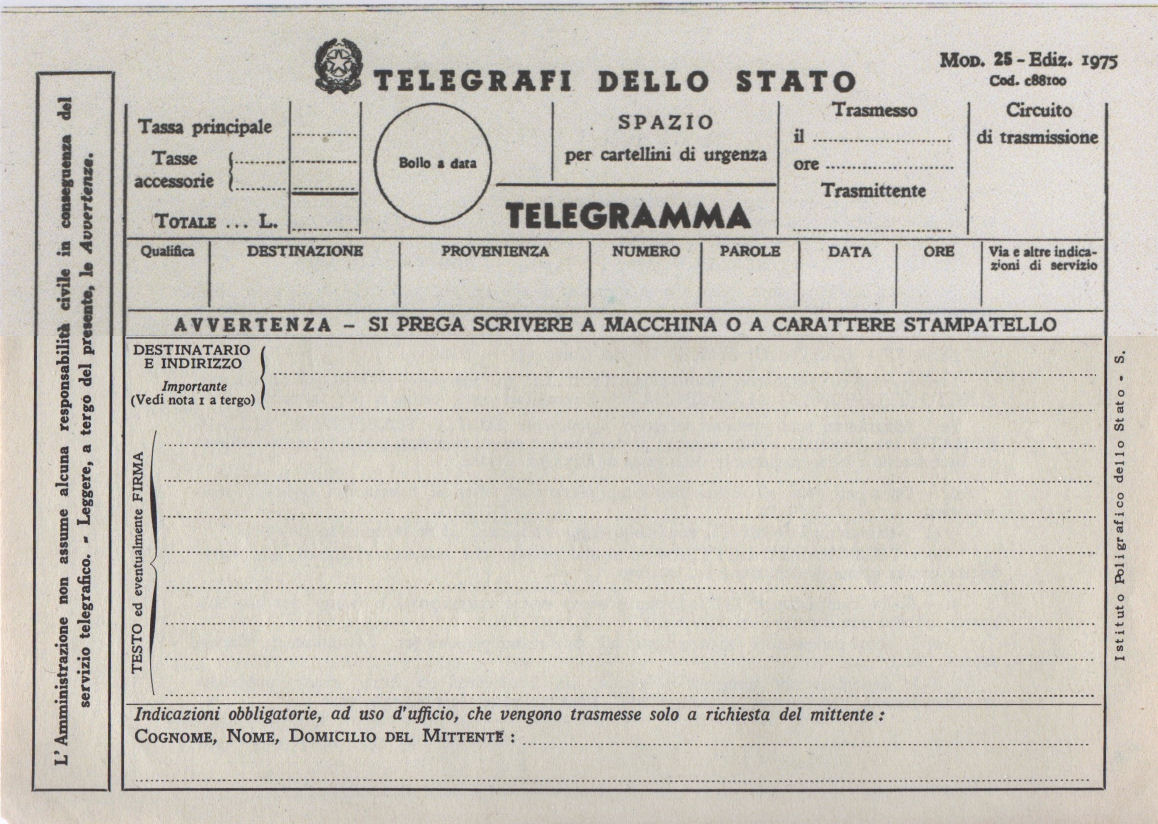
The form number is at the top-right, and there is an imprint up the right side :


Images courtesy of Les Bottomley.
A more recent unused multilingual State Telegram of 1991. It has instructions in Italian, English, French and German.
Top-right has the Form number "MOD. 25 - CODICE 088100 - EDIZ. 1991". Ignore the seal from the 1880's, just added for decoration.
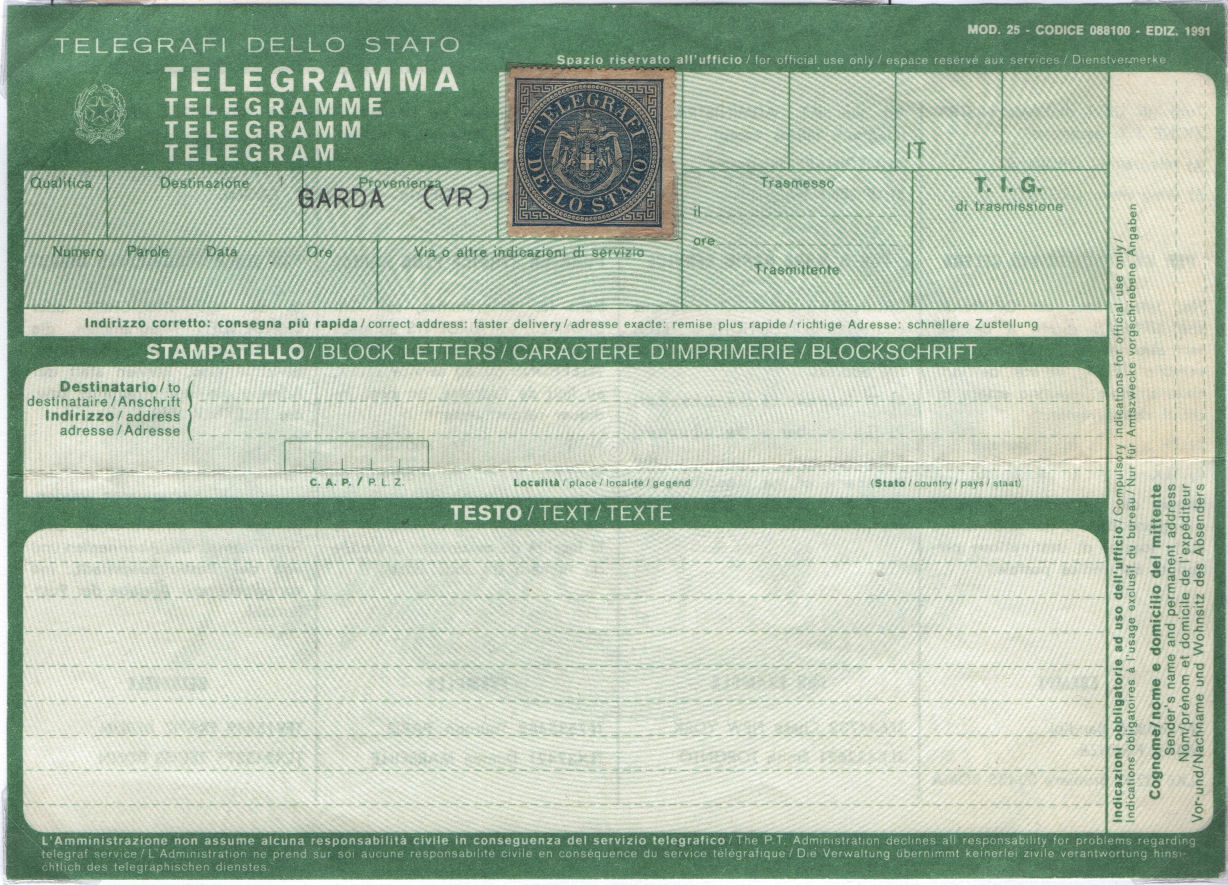
No imprint. Courtesy of Les Bottomley
Modello 60
A telegraph Form used 1941 in Savigliano, a comune of Piedmont, northern Italy.
Form number at top-right: MOD. 60
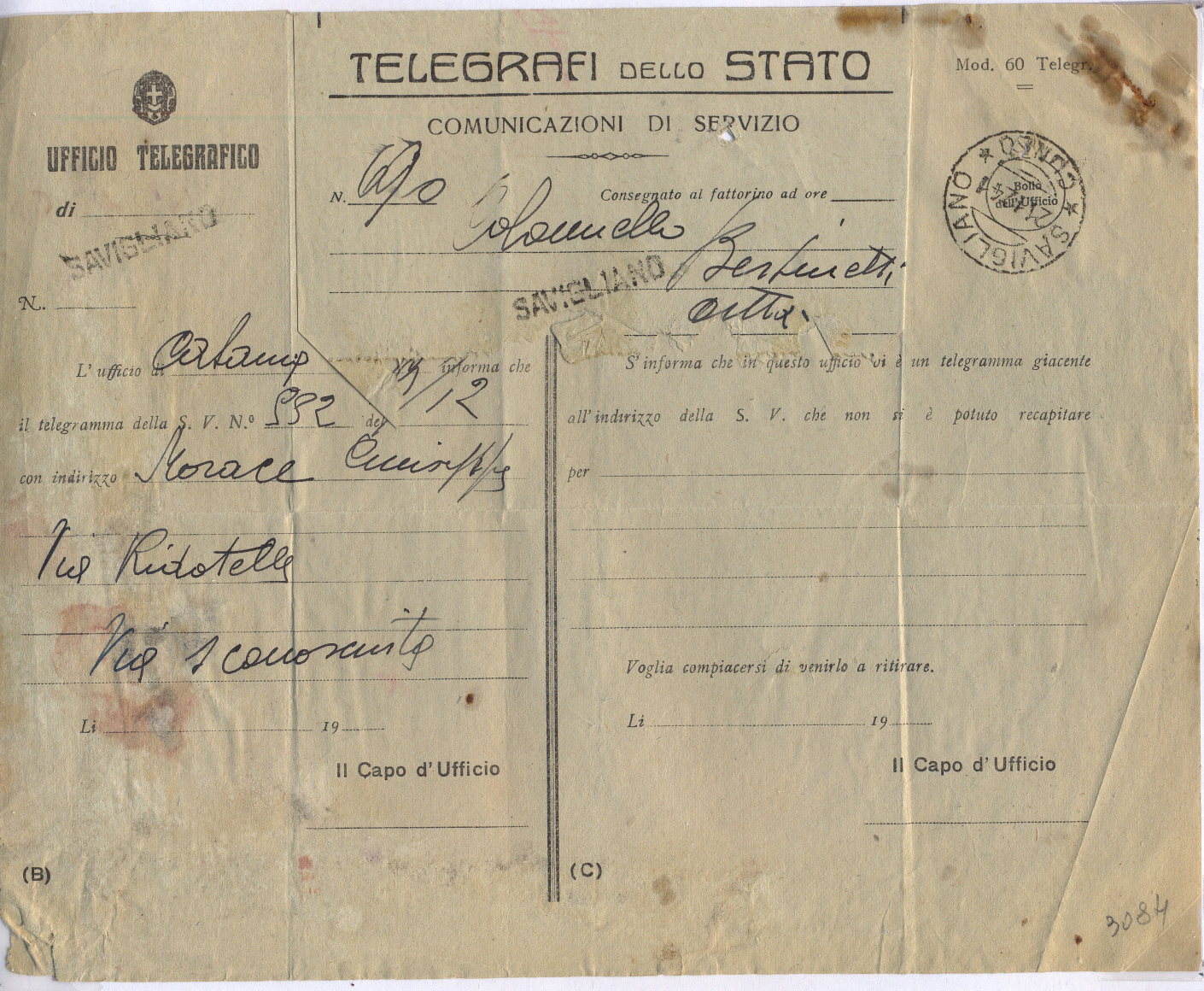
Image courtesy of Rolf Lamprecht.
Receipt of 1908.
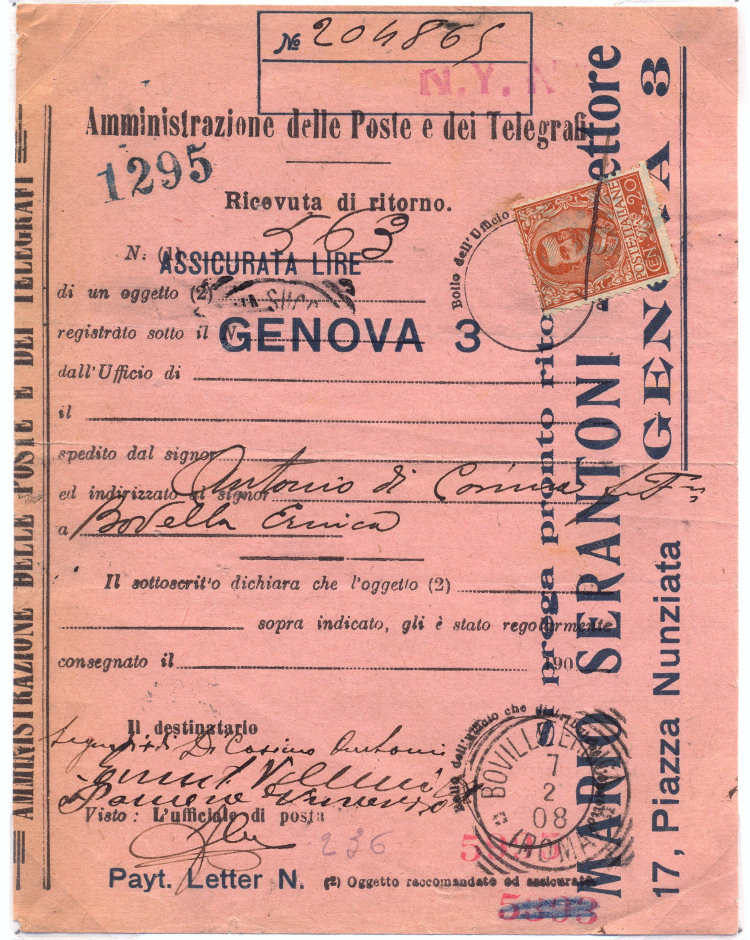
Courtesy of Rolf Lamprecht. |
|
Modello 45
In 1925, Italcable completed a Cable from London to Italy via the Azores and Malaga.
This telegram was received at Milan on 13 May 1953 from England
Form number "MOD. 45 - Ord. 2281/55 - SAV . Napoli"
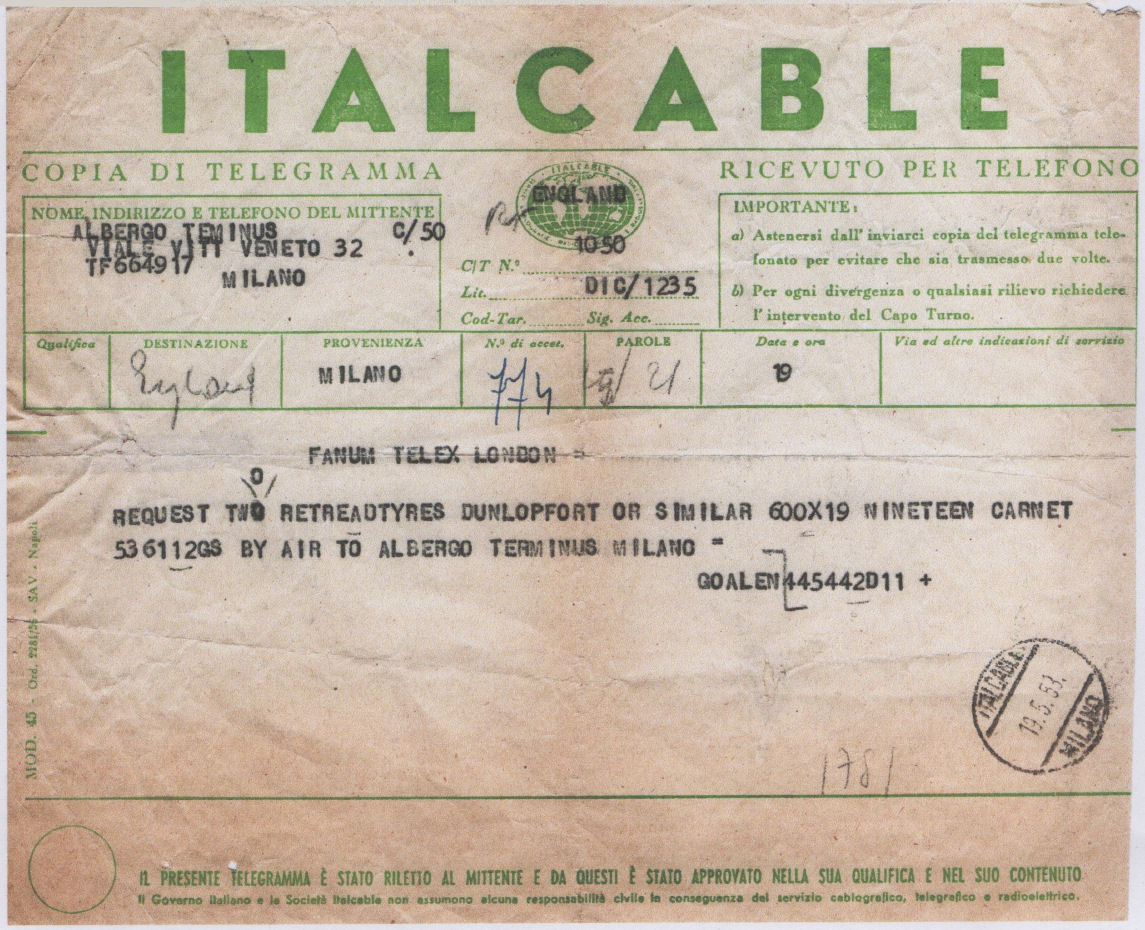
Courtesy of Les Bottomley |
Modello 32
A Form used in 1966, I think to pay a telephone bill. A calculation at the top reads 50 x 28 = 1400.
Postage due stamps are affixed to the value of 1400 Lira and cancelled with "Poste Piacenza Centro / Tassate". Tassate = Taxed.
Up the left side is "Amministrazione della Poste e dei Telegrafi", as seen on the form to the left above.

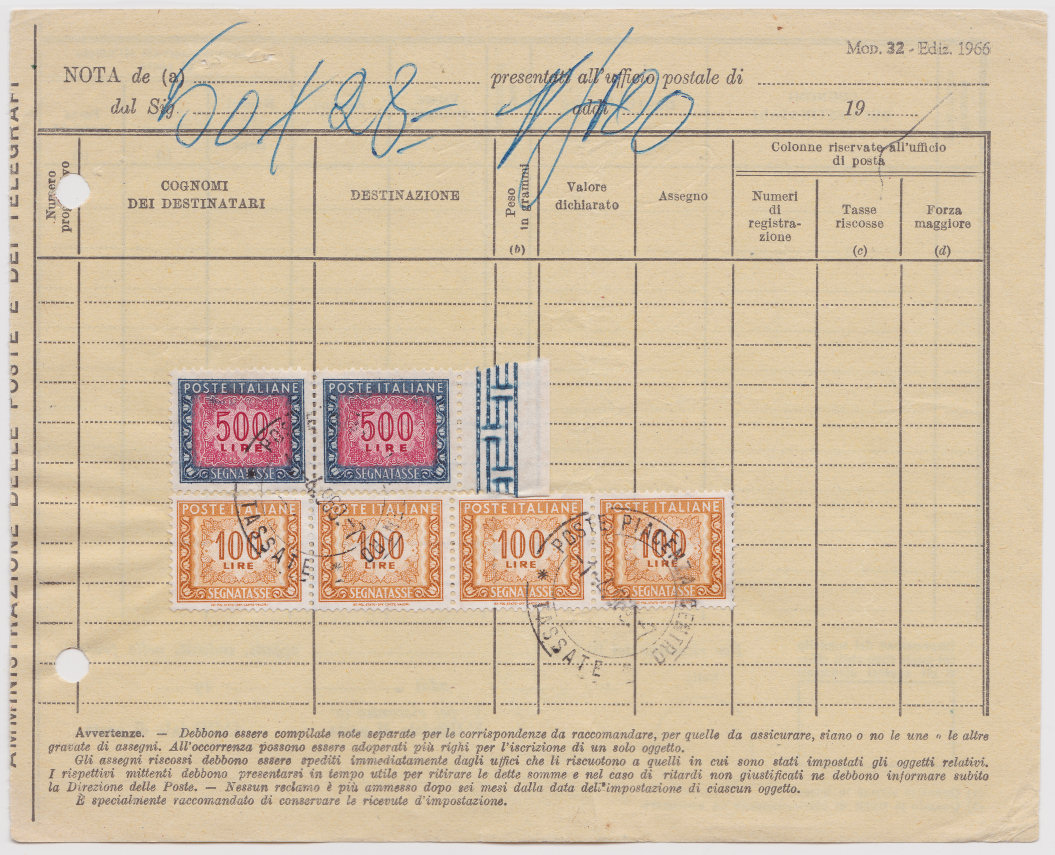
I would think that the forms with the calculation was mailed to the customer with mint stamps attached.
The customer would then pay at the nearest post office, the stamps cancelled, and the form kept as a receipt.
The holes on the left were from the customer filing them.
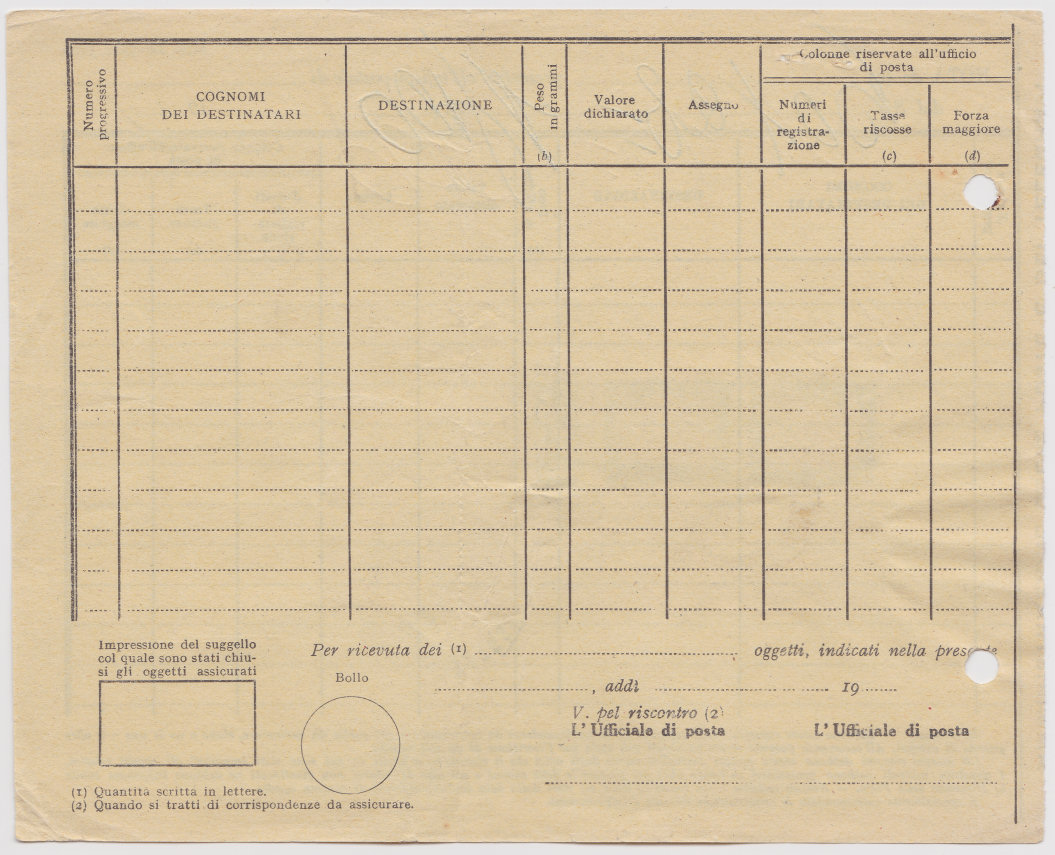
The form allows for an itemised listing, but the calculation suggests a flat rate of 50Lira per call was used for this.
A similar Form used in 1968, with a calculation at the top reading 50 x 55 = 2750.
Postage due stamps are affixed to the value of 2750 Lira and cancelled with "Poste Piacenza Centro / Tassate". Tassate = Taxed.
The left side is now perforated, making it narrower. The font is shorter and wider.

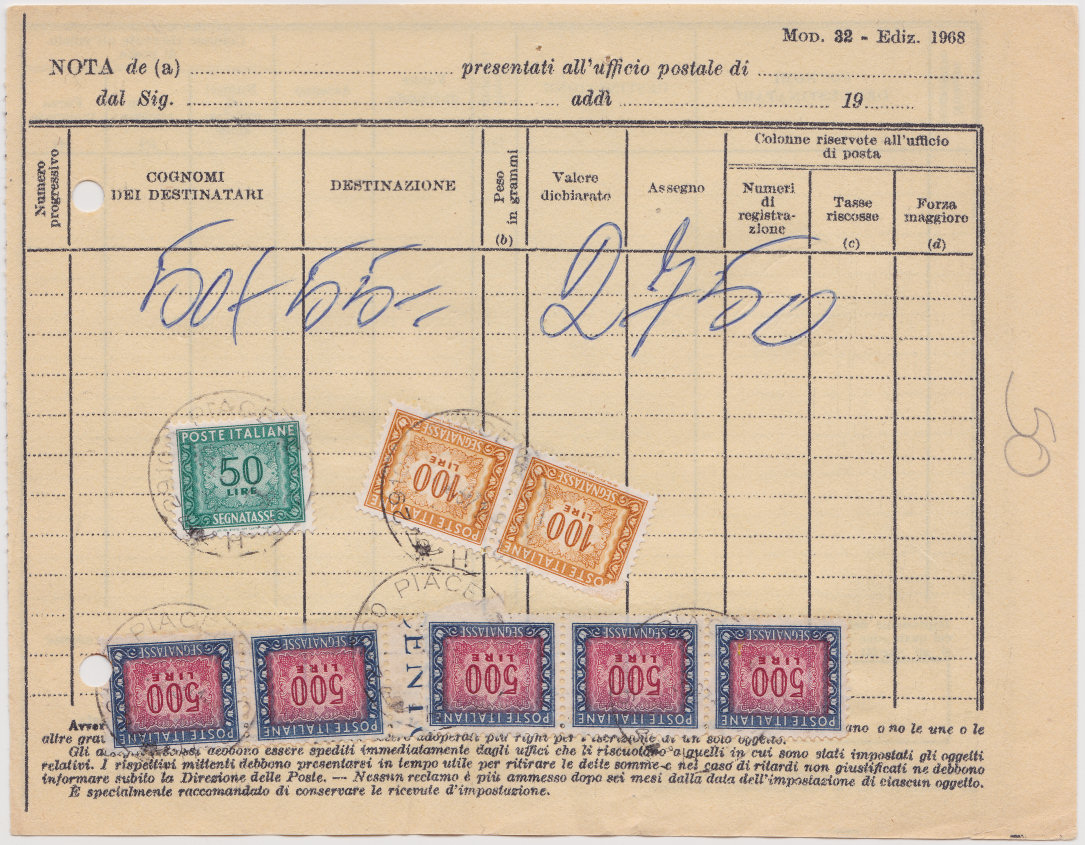
A h hole goes through a stamp indicating that it was added later.
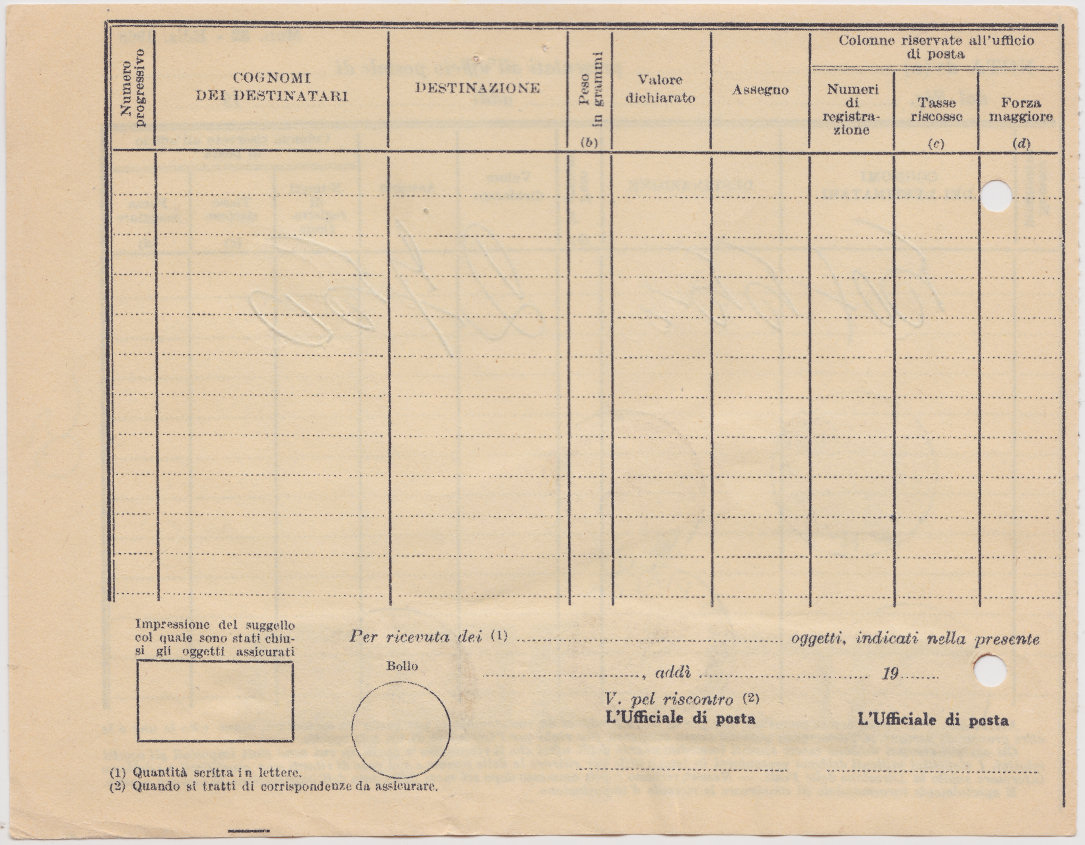
Eritrea
British Administration 1941-1952.
For background information/history see wikipedia.org
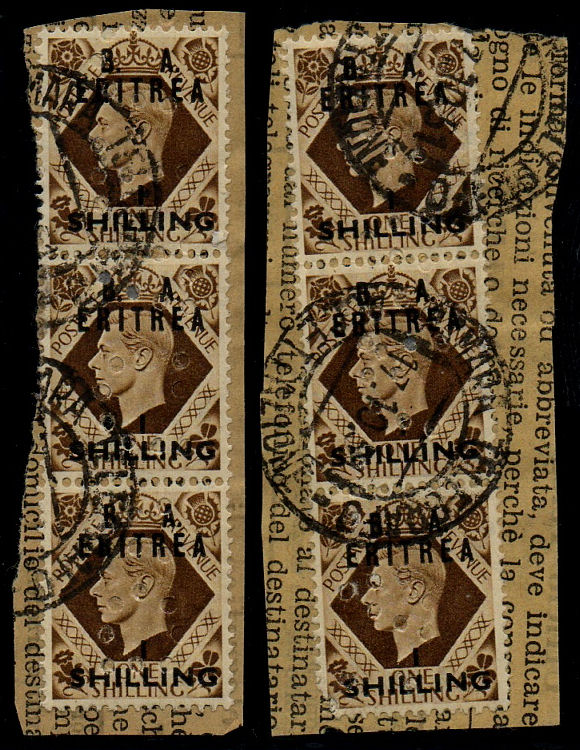 |
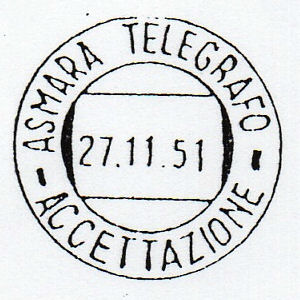
'Asmara Telegraph Acceptance' cancels of 1951. Asmara had been the main Italian town.
These Telegraph forms are in Italian and the stamps are additionally punched
with the Italian word for 'PAID'.
It looks like the Italian Telegraph procedure was still in use.
Only the stamps had changed.
Presumably there are similar examples with Italian stamps,
unless perhaps the Italian authorities had been more dedicated to destroying used forms.
Images courtesy of Jeff Turnbull. |
 |
Here is both sides of a complete form (Mod. 25 Ediz) used 16 November 1951:
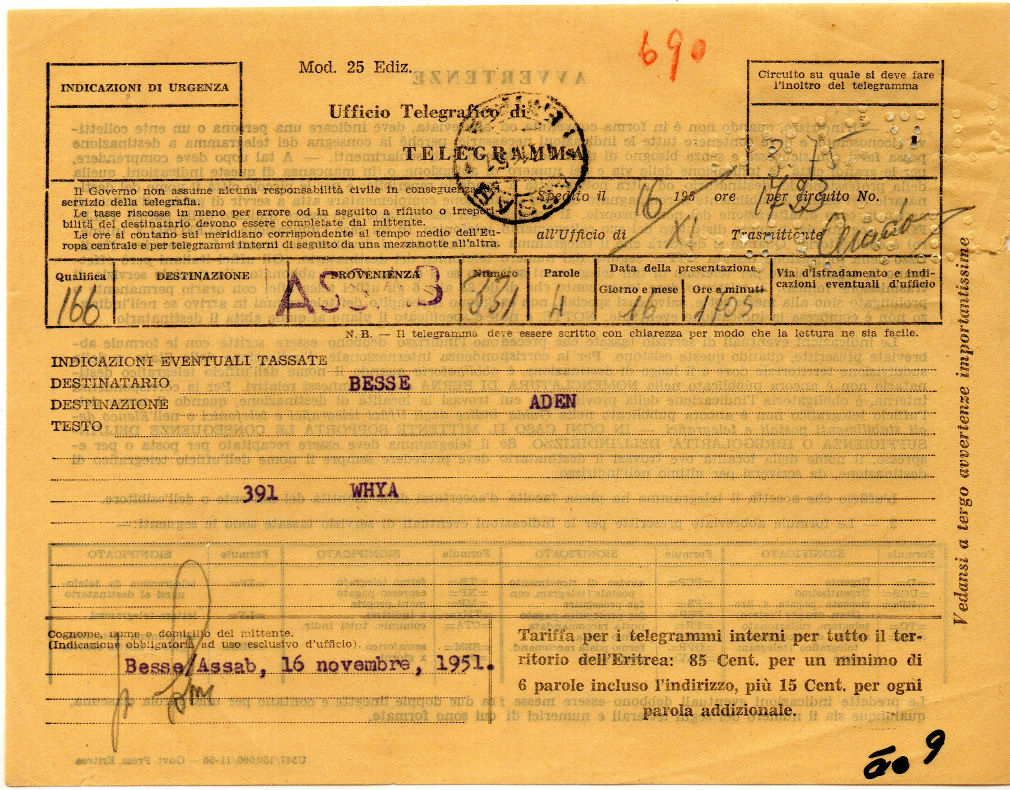
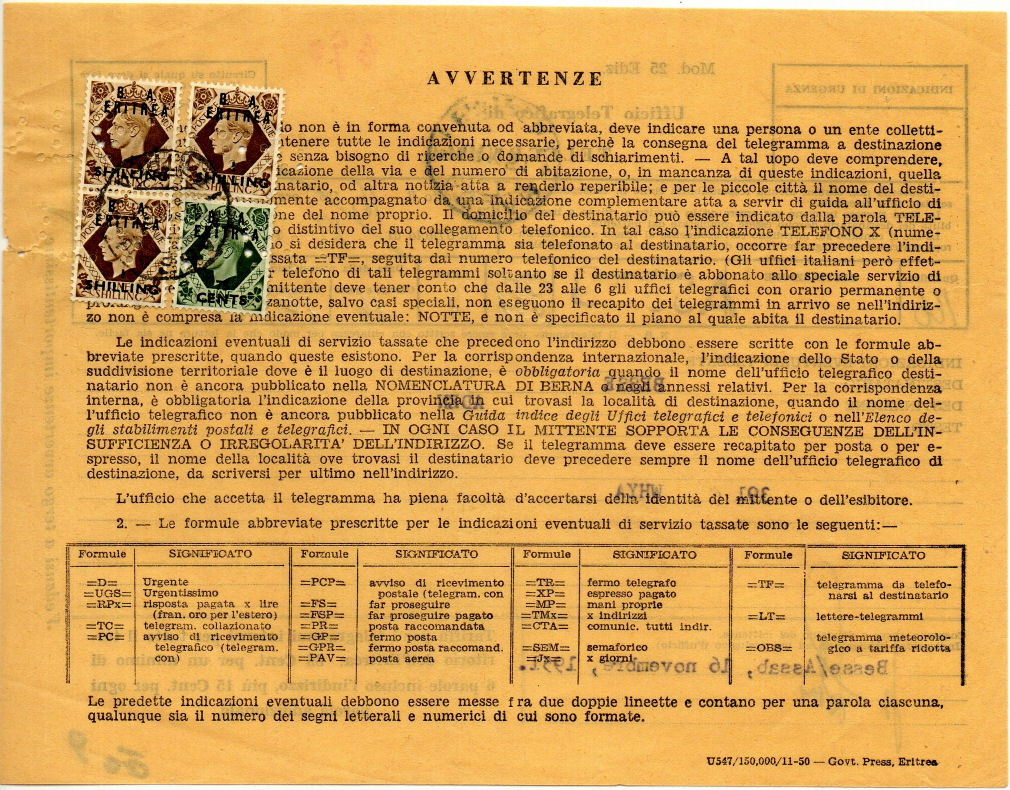
It is from Assab, a port to the south of Eritrea to someone called Besse in Aden across the Red Sea from there.
The 'Urgency' is not filled in and the 'Text' is rather cryptic. Perhaps these account for the survival of the complete form.
Notice 'U547/150,000/11-50 - Govt. Press, Eritrea' at the bottom, 150,000 printed November 1950 apparently.
Images courtesy of Jeff Turnbull.
Not all forms were the same. A collection of postmarks on receipts (Ricevuta) of 1952 shows these:
The receipts (Ricevuta) appear to be parts cut from the form, but they are not parts of the form above.
Stamps other than receipt tax stamps, are normally on the form, not on receipts. They are to allow auditors to check on the officials.
The receipts are marked 'Serie A - N. 27', 'Serie A - N. 39' and 'Serie A - N. 42' where not covered by stamps.
I am not sure of the significance of the number. The forms may have come from a booklet with matching numbered stubs.
These images are courtesy of Jeff Turnbull.
Comments, criticisms, information or suggestions are always welcome.

Please include the word 'Telegraphs' in the subject.
Last updated 29th. August 2023
©Copyright Steve Panting 2012/13/14/15/16/17/18/19/20/21/22/23 except where stated.
Permission is hereby granted to copy material for which the copyright is owned by myself, on condition that any data is not altered and this website is given credit.


